#and from the director's perspective it is masterfully done
Explore tagged Tumblr posts
Text
There's probably not a better example of a love-hate relationship than me and the ballet Onegin.
Like I love the piece to no end. But I positively HATE so much of what Cranko did with the source material and its characters...
#ballet#onegin#once again in my hyper obsessive onegin era#john cranko#a. s. pushkin#there are so many great details in the ballet#and from the director's perspective it is masterfully done#but then there are even more moments where I just screm#demanding to know what THE HELL possesed you John?!#how could you not get so many things#how could you not understand what seams like the basics for the story#and more so the characters?!#what were you thinking pushing the relationship between Olga and Lensky forward#making it seems like a picture perfect romance#which it most certainly WAS NOT#no matter how much Lensky would like to believe#and then omit COMPLETELY the whole friendship between Lensky and Onegin#I love your choreo with all my heart#but I will never forgive you for that omission#and for how hard you made it for the dancers who actually read the book and would like to stay faitfull to it#and its author#pushkin over cranko#all day every day#diagnosis onegin
9 notes
·
View notes
Text
"Rashomon" is such a messed up film, I loved it
I don’t usually see classic films—or anything made in the nineties. For some reason, their bad cinematography had always irked me, and their camera angles disgust me to this very day.
In the last couple decades, technology has advanced at a fast rate. And you can really see that if you’ve seen these classics. They just have a different vibe to them. And as someone who consumes a lot of latest cinema—and anime—it’s actually really tough for me to accustom myself to the cinema of that time.
But, you know what, my university doesn’t care. They made me watch Rashomon, a film by the legendary Akira Kurosawa.
For those of you who don’t know who Akira is: firstly, shame on you. Secondly, he’s one of the most influential Japanese directors who is known on an international level. His films were brimming with professional creativity and they really influence many directors. In fact, he’s the sort of director whose films are studied in film-schools.
I knew the director and what sort of a legend he was, so I was really excited for the film. But considering his last film was in ninety-three—and Rashomon, by the way, released in nineteen-fifty—I was kinda… expecting myself to not like it…
I loved it.
So much that I can’t stop myself from writing this blog and yapping about its themes and plotline and characters and direction and all that technical stuff.
***
#01 - Plot
You know how we start reviews here, lol. So, the movie Rashomon follows a priest and a woodcutter contemplating in a shrine, under the rain. A commoner arrives, all drenched up, and begins making fire and drying himself and his clothes as he tries to make small-talk with those guys. He noticed it—the two men were genuinely worried about something. So he simply asked what the case was.
The woodcutter starts yapping about how bad the humanity is, how evil is spreading all over our tongues. He told the man the story is more horrific than war, famines, murders. The story is about how he, in the middle of the forest, witnessed a samurai’s hat, a woman’s hat, an amulet, a bunch of cut ropes, and… a dead body.
He did the obvious—inform the authorities. And what happens next is… quite absurd. So absurd that I can’t explain it here. And I don’t even want to. Just know that there are different characters—a bandit, a woman, a samurai. And all tell their side of the story about how the death of the samurai took place.
And their accounts vary too differently from each other. The bandit talks of his valor, the samurai of his despair, and the woman of her innocence.
But here’s the catch—the accounts don’t match with each other. All of them have different stories to tell. And then—spoiler alert—the woodcutter tells how he himself had lied; he had seen the whole scene unfolding, but refused to tell to the court. His account seemed to be the most trusted one, but since he had his reasons to not reveal this story to the court, you can never be too sure.
In fact, the film is known for this—you never know the truth about what actually happened. You just hear from the characters—and they won’t tell you the truth. They have their motives to lie. Rashomon Effect, a screenwriting technique where an incident is shown by different characters’ differing—and even contradictor—perspectives is loosely based on this film.
The writing of the film is done masterfully, especially in terms of the plot. And the setting justifies it—the story is based on a couple centuries ago, so you can't really know the truth if the people are not lying, because the technology isn’t so advanced yet.
***
#02 - Characters
The characters are absurd. Some of them are even screwed in their minds. And no, I’m not joking.
The bandit just cared about his image. He told the court how he lured the woman into his charms—which seems highly unlikely—and how he didn't even need to kill her man. And he told her how, after dishonoring her, he cut the ropes of the man and went for a fair fight for the woman and defeated him. The guy was just flexing shit he didn't do.
The woman, on the other hand, knew what happened with her was not acceptable. She knew that society wouldn't see her as a victim. She knew she’d get side-eyed. So she tried to convince the court of her innocence. She cried crocodile-tears. She begged for mercy. For forgiveness. And she tried to appear as innocent as she probably could.
The samurai… Imma talk about him later. But yeah, as the woman had predicted, he said he didn't see the bandit as the convict, but rather believed that his wife was at fault.
These guys are messed up in their heads. The bandit was too dumb and full of himself that he just flexed his physical and mental muscles. As is later revealed, the woman was at fault too, and she used her wits to get her husband killed. And then she ran away. And the samurai’s whole belief system was all around the place.
These characters so obviously symbolize different sorts of evils that are present in society. And the different reasons we lie. We lie because of these three reasons—we don't understand the truth, we wanna hide what we did, and we wanna make an image for ourselves. The samurai, the woman, the bandit.
***
#03 - Themes
The story tackles a number of themes, the most obvious being what’s truth and what’s lie. And, on a deeper level, why do we even lie.
The film is an example of… those kinda films where characters are really screwed up, the story is really screwed up, and all the stuff that happens needs to be psychoanalyzed. Like Chainsaw Man. Or something like that. I hope you kinda get what I’m trying to say. This sort of story may not be realistic, but it seems to explore the darker sides of humanity and is based on simply complex characters who are screwed in the head.
The film answers a pretty important question—why we lie. There are different characters, different perspectives on the murder, and none of them seem true. Every one of these characters seems to be lying one way or the other. Even the most unbiased, trusted account—that of woodcutter’s—could be false, since it’s revealed how he had his own reasons to lie.
You don't know the truth. Not even in the end. You don't know who to believe and who not to—that’s what the film has taught you.
All these characters had different sort of motives to lie. The bandit tried to show what kinda womanizer he was and how clever his plan was. He tried to do the impossible, get what he knew he couldn’t get, and still came out victorious.
The woman, on the other hand, tried to convince the court how she did nothing wrong—in fact, wrong was done on her. She even tells the court how sinful she felt, and then tries taking her own life because of it.
The samurai, who had died, was contacted through a spirit-medium. He told the court of the despair he felt, the sense of shame he was drenched in, and the loss he faced after the incident. He said how he saw the real face of her wife that day, which depressed him so much that he killed himself. For the sake of the plot, let’s say all that spirit-medium stuff was real.
Everyone had a reason to lie. Everyone wanted to show themselves in a particular way—the bandit wanted to show how clever he was, the woman wanted to show how innocent she was, and the samurai wanted to show how depressed he was. The woman put all the blame on the situation, the bandit on himself, and the samurai, oddly enough, on his wife.
Another theme I saw being well-approached was that of patriarchy. I mean, the story is set in Japan centuries ago. There were a lot of talks on the honor of a woman. The samurai didn't see how his wife was raped, he believed it was his wife’s fault. From his account, you can’t say he hated the bandit—the rapist—one bit. But he despised his wife. He told the court how his wife switched sides, even though the woodcutter’s account says how her wife freed him after being raped and begged him to kill the bandit. But the samurai refused to fight him for a ruined woman.
Those are not my words, for the record.
Also, the woman then, quite shrewdly enough, attacked their male-egos and made them fight a duel. Where the bandit killed the samurai. And she ran away from the place after that.
The samurai’s story tells us how messed up his patriarchal beliefs are. And how the woman quite easily made him fight for her just with a simple you’re-not-a-real-man-if argument.
And, according to the woodcutter, they didn't even know how to use swords—something that none of the two guys ever told the court. Rather, they were busy telling how quite bravely they fought.
So, on a thematic level, the movie is quite well-thought. I still believe there must be a lot of themes that I’ve completely missed—that’s how dense this story is.
***
Conclusion
Watch the film. I didn't want to, but I’ve given you a lot of spoilers. And because of this alternating between what to hide and what not to, I did a pretty messy job. So I want you guys to watch the film. And then come back here again, on this blog.
And yeah, I hope you guys have a good time reading it. I yapped too much, but I wanted to yap more, lol.
#film analysis#film review#movie review#movie recommendation#review#criticism#media analysis#akira kurosawa#japanese cinema#cinema
5 notes
·
View notes
Text
REVIEW - Insidious: The Red Door - A Perfectly Fitting End to the Series

Insidious: The Red Door is the final installment in the franchise which started with James Wan's Insidious in 2010.
Insidious: The Red Door is Patrick Wilson's directorial debut after starring in the series as Josh Lambert. And he even sings in the film's credits in a collaboration with Ghost, showing everyone his many talents as actor, director, and singer.
Insidious: The Red Door is already a great conclusion to the Lambert family's story, but it's also a win for Patrick Wilson fans who long for him to sing in more of his films--especially after the iconic Can't Help Falling In Love scene in The Conjuring 2. The cover of Shakespears Sister's Stay is a perfectly fitting song for the Insidious series.
Insidious Chapter 2 ends with Josh (Patrick Wilson) and his son Dalton (Ty Simpkins) choosing to forget the Further--the dark realm to which they travel while astral projecting--and even with a nine year time jump, Insidious: The Red Door picks up where we left this plot thread, explaining the dangers of forgetting our past rather than working toward making peace with it and finding a healthy and safe path forward.

Forgetting has left Josh with a brain fog he can't explain--constantly feeling like there's something missing in his mind. This disconnect has made him grow distant from his family, causing a chasm in their once warm and hopeful home.
Insidious: The Red Door expands on the story set up in the first two Insidious films, and does a great job connecting everything together to tell an honest story of generational trauma.
Patrick Wilson's directing powerfully brings the Further back and it looks better--and spookier--than ever.
One of the film's most powerful moments comes when we revisit a scene from Chapter 2, but from a different perspective. Using unused footage from the earlier film brings this moment to life. It truly feels like we are experiencing a memory unfold from Dalton's point-of-view. The new and existing footage blends together seamlessly, creating a mesmerizing visual--and one where we can feel Dalton's emotions through seeing this damaging memory through his eyes.

Insidious: The Red Door is an extremely personal and emotional film, focusing on the strained relationship between Josh and Dalton. Patrick Wilson and Ty Simpkins give complex performances highlighting the trauma and lived experiences of their respective characters.
The dynamic between father and son makes for an interesting film exploring trauma as well as generational differences and how shared experiences can bring us closer together.
In addition to its metaphors of the further representing the Lambert's trauma and their attempts to forget, Insidious: The Red Door also succeeds in its moments of visceral and suspenseful horror.
The Insidious franchise has always done a great job with its well-crafted jump scares, and The Red Door is no exception.
Jump scares can sometimes be quick, relying only on the surprise to frighten us, but Insidious: The Red Door creates its scares through a haunting, build-up of suspense. These scenes of horror utilize shadows and light masterfully, and create even more suspense through repetition and unexpected scares.
As the camera pans to the same spot or the lights flicker, we are still surprised by the location within the frame or the timing of these scares among the repetitions.
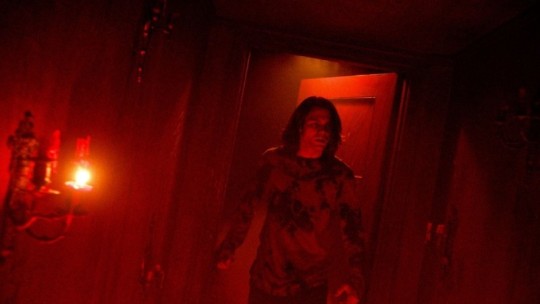
The Insidious films always have an underlying humor, conveying horror tropes and embracing the natural camp of the horror genre.
Insidious: The Red Door takes the familiar trope of children creating creepy drawings and instead of making it a result of the hauntings, it becomes a part of Dalton's character and a major aspect of the plot. Dalton's childhood drawings of what he saw in the Further have resulted in him being a talented artist going to art school.
There is a fitting campy energy from taking this common trope and asking us, what if this child who could miraculously create creepy works of art is actually a talented artist.
The film's finale also embraces camp and absurdity--once again connected to Dalton's painting. This surreal ending with its metaphorical ties to the film's darker, serious themes recalls classic surreal horror moments such as John Trent (Sam Neill) in In The Mouth of Madness breaking through the pages of the novel of which he is a fictional character and later, watching himself on screen in a movie-within-a-movie adaptation or Heather Langenkamp--playing herself--reading the end of the screenplay in Wes Craven's New Nightmare.

The moments of campy horror create a great tone, but at times, the film relies on jokes, and these moments tend to fall flat. The natural humor comes from the film's exploration of horror tropes, but doesn't work when it comes to scenes of college frat comedy.
For a final film in a franchise, sometimes new characters are not given enough development or screentime, but that isn't the case with Insidious: The Red Door. Dalton's roommate and confidant Chris (Sinclair Daniel) is a great addition to the franchise.
Chris is a great character who adds to the film, creating wonderful moments of suspense, because we care what happens to her. Sinclair Daniel gives a great performance, capturing the character's unique personality and weirdness that fits with Dalton's. There is an easy chemistry between the two characters and we can't help but get attached to their budding friendship as Dalton uncovers the secrets hidden away in his mind with Chris's help and encouragement.
***
Patrick Wilson's directorial debut Insidious: The Red Door is a captivating exploration of generational trauma brought to life through Patrick Wilson and Ty Simpkins' performances and challenging dynamic. Insidious: The Red Door shines with its well-crafted jump scares, beautifully haunting cinematography, and blend of memory and reality.
Review by Amanda Mazzillo
6 notes
·
View notes
Text
Reviewing My Anime 10/10's *Relatively* Spoiler-Free
Note: What I rank a 10/10 is very specific and obviously very subjective to my own. Something can only be a 10/10 if I already consider it a 9/10 AND I must have rewatched it. I am someone who typically does not rewatch/reread anything, unless it's something I truly absolutely enjoy. With that being said, because of the requirements, I only have 4 animes that I rank 10/10, and tbh only one of those animes would get that ranking from the general anime audience. The rest are SO SO SO specific to my particular tastes that I would be absolutely stunned if someone also had the same four as me, because the requirement is so specific. Imma make another post eventually for my 9/10's because I think that list makes a lot more sense for a general anime audience lmaooo.
Soooo, in order of least personal to most personal (although obviously they're all personal to me lol) we have:
1. Psycho-Pass
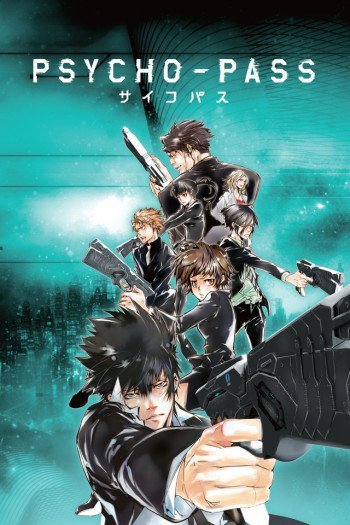
Recommended for people who: are really into that dark dystopian future society vibes, are fans of Ghost in the Shell, like detective/crime stories
Okay, for a few people, this one actually probably makes some sense. At the moment, it has an 8.37 on myanimelist which means this anime is super well liked. I've watched this anime twice, first the original and then the second time I watched the director's cut (yes that exists lol). Overall, I'm a huge fan of the entire Psycho-Pass anime series as a whole. I've watched all three seasons, as well as two of the movies. I didn't watch any of the Sinners of the System ones cuz tbh I literally couldn't find an english sub of that anywhere, it just doesn't exist lol. I think it's okay cuz the ratings for the Sinners of the System trio of movies seems meh. I've actually watched Psycho-Pass the Movie like three/four times LMAO but that's simply cuz a movie is obviously much quicker to watch than an entire anime season. Like just objectively, the Psycho Pass series as a whole is very inconsistent in quality due to the fact that it's all original, so they do technically just make up everything as they go lol. Season two is all right (I think it gets more hate than it should), three is good but season one by far is the absolute best in the entire series. I'd argue the movie is technically my absolute favorite out of the whole IP, but I actually give the movie an 8/10. The movie, because of being obviously way shorter, simply does not have the deep controversial and philosophical lines of thought that season one has. It lacks that extra depth that would make me put it anything higher than an 8. The two main characters have good chemistry as a crime-fighting duo and the main villain's rivalry/relationship with the male lead is super compelling. The female lead is meant to be relatively naive/more on the innocent side which works with the plot as it allows the show to naturally explain and give more exposition as to the actual world and rules of Psycho-Pass without having it seem so ham-fisted or just throwing info to the audience.
2. Violet Evergarden

Recommended for people who: cry to sad movies, like gorgeous animation, are very empathetic, like vignette-esque storytelling
All right if you even remotely consider yourself an avid anime fan, then this anime is probably also somewhere on your 10/10 list or at least an anime you consider to be "very good." That is, unless you are that very vocal minority who simply really just REALLY do not like this anime for some god forsaken reason. However, in my honest opinion, I think an anime like this just really doesn't sit well with ... how do I put this blunty ... people who do not give a fuck about other people or anyone else's feelings but their own. Basically, IF YOU ARE SELFISH, A NARCISSIST, EGOTISTICAL, OR ANY SORT OF COMBO OF THOSE THREE, YOU WILL NOT LIKE THIS ANIME. And if you do, you probably don't think you're any of those things. Because of the anime's very premise, I find it very difficult to see a very self-centered/heartless person particularly enjoying this anime. The whole premise of this anime is that the main character who, because of her upbringing, doesn't understand feelings/emotions, especially the concept of love, grows as a human and slowly begins to learn what love is. The show does this by showing multiple sets of characters meant to represent different types of love (romantic, familial, platonic, etc). The vocal minority of people I've seen give Violet Evergarden bad ratings all typically argue that although beautiful, the anime doesn't have any substance/doesn't really mean anything. If that's honestly all you got after watching the entire show, then you deadass just don't get it, and you probably will never ever get it. If you've seen or heard of Vivy: Fluorite Eye's Song, than just know that these two animes are VERY very similar in vibe despite being technically different genres. However, I personally found the themes and concepts in Vivy are done much more masterfully in Violet Evergarden which I think is due to Vivy's heavier focus on a story-driven overarching plot/action as opposed to Violet Evergarden's focus more on emotional impact/an episodic format. I've watched the entire series and I've rewatched the main show twice. TBH you can probably skip the gaiden movie AKA the one set at the girl's academy it was highkey pointless. Compared to the opera episode they added as a "special", the gaiden movie was still good but I wish resources were dedicated to something that actually added to the story. ALSO YES I KNOW ITS A GAIDEN AKA A SIDE STORY AKA FILLER SO YES NO DUH IT DIDNT ADD ANYTHING, BUT STILL. As for the main show, I think I cried for three episodes (the one about the playwright/author I forgot lol, the mother and daughter, and the soldier). On my rewatch, I didn't cry but I still deeply cared for and related to the characters. Violet Evergarden is a beautiful anime with a beautiful story.
3. ACCA: 13-ku Kansatsu Ka
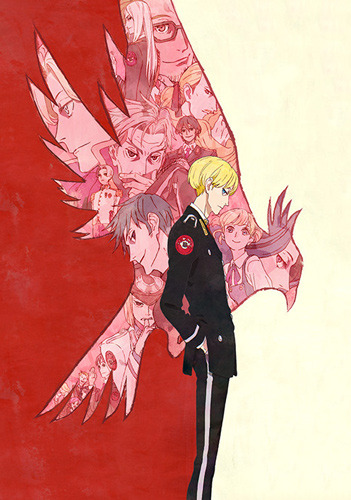
Recommended for people who: like bread and bakeries, don't mind a very chill and slow-paced story, like stories about political intrigue and hidden agendas
Based on a relatively short manga, ACCA: 13 follows the main character Jean Otus as he performs his job of auditing the 13 districts of his country Dowa, while rumors and politics brew in the background that threaten to entangle Jean into a complicated plot. To be honest, I think properly reviewing this anime is impossible for me, because I just can't really explain the vibes of this anime besides "chill" and "intriguing." I think trying to explain anything more than the basic premise I just wrote would spoil a lot of what ACCA is, because it's plot is actually relatively quite simple and straightforward. Compared to Psycho-Pass which has a relatively good cult following, and Violet Evergarden which is universally praised, ACCA is an anime that I've yet to personally meet anyone who has ever even heard of it LMAOO. And almost everyone I know watches anime, so that's saying something oof. ACCA is made by Madhouse, which if you don't know, is a super well known anime studio, producing big hits such as Death Note, Hunter x Hunter, One Punch Man, etc. That's why I'm surprised that ACCA has flown just SO under the radar, but that may be due to the overalls nature of the anime itself. ACCA is an anime where all the characters hold their card close and no one seems to really share their real thoughts. One main criticism the anime has is the lack of deeper connections to characters and that for a main character, Jean Otus is very bland. To be honest, I think that's a very fair criticism and I can understand why this would prevent people from rating this anime higher than an 8 or 7. Due to the very nature of the anime and its plot, I do agree that there is a huge cast of colorful characters that we unfortunately don't really get to know more about. To be honest though, I don't mind this because I feel that's honestly quite realistic, especially factoring in Jean's job. All these places he's going and all these people he's meeting, it's literally just his job. He's not on vacation, these people aren't his friends, so the anime has no real reason to dwell much longer on places past its specific episode. Just like in real life, you encounter so many people and go past so many places that you probably won't ever see again. So for me personally, I didn't mind that the anime didn't explicitly show much about the backstories or lives of the cast, save for the very main characters (as their backstories were plot relevant). I think as viewers of not simply an anime, but a whole other world, I think it should be satisfactory to inherently understand that these are whole "people" who have entire lives that we are not exactly privy to. So although admittedly our understanding of many of the characters was all around quite shallow, I think that works for the scope of the anime, which was relatively simple and focused on just Jean living his life and the political plot stirring in the background until it was brought forward in the second half of the anime. Also I love Jean Otus. I actually completely absolutely adore him. He is literally my profile pic for myanimelist LMAO. I think calling him "bland" is fair from other people's perspectives, especially as the supposed main character of an ANIME, but I feel that if ACCA was in a different format like a novel, I think his personality would have been less criticized. Like I said, I love him soo much. I don't find him bland at all, but actually very interesting and highkey attractive LOL (if only he'd quit smoking but it's part of his charm 😞). Yes for an anime "protagonist," he is quite underwhelming especially compared to others, but I think that makes him very charming!!! Like all he wants to do is just chill, vibe, and do his job lmaooo. I think as a person, he’s very charismatic, and in the world of ACCA the rest of the characters see that as well. Because like, if he really were such a bland person, why would so many people like him and actually trust him lol? As for why it’s technically my favorite anime of all time (my ultimate one is a movie), I can’t give super detailed reasons why to be honest. I just really like the overall vibes of the anime itself, and I think the anime is just super unique and original. I’ve watched a ton of anime over the years, but I’ve genuinely seen nothing like ACCA in the slightest. I mean, just look at the recommended animes on the myanimelist. The recommended animes are all stuff I’ve also personally really liked (like fugou keiji unlimited and the great pretender) but yeah there’s just truly nothing that’s close to what ACCA is, and because of that, it reminds my absolute favorite anime show. I’ve seen the dub and the sub, even though I am a vehement dub hater lmaooo (except for very few circumstances, and this also applies to all non-English media, not just anime). There was only one thing in the entire show that slightly confused me/ seemed slightly unbelievable and I won’t spoil but it had something to do with the overall timeline of some events, but it doesn’t detract from the story at all. Oh and the art style! I really love the art style of the anime. It stays pretty true to the manga, but is also just an overall kind of art style I really like. I really enjoy the more like 2d/flat/drawn art style versus really clean and really detailed stuff, and I’m typically not a big fan of very obvious use of CGI (unless done tastefully like in Demon Slayer). All the backgrounds in ACCA have this painted/drawn style and the anime itself has this like muted(?) filter over it that makes the anime seem like someone’s drawings just put up on display in a way that’s really refreshing and nice. I highly recommend this story for anyone who wants a breath of fresh air and to get away from the typical action-packed high energy of big name anime.
4. From Up on Poppy Hill

Imma make a whole separate post JUST for this movie so I can explain why I love this movie so so much. And honestly, Imma need a whole separate post in the first place to address the elephant in the room when it comes to this movie (if you’ve seen it, then you know what I’m talking about). And if you’ve haven’t seen the movie, maybe you’ve heard about one of its controversial themes. I’m not gonna say what it is, cuz I KNOW it’ll be super off-putting for a lot of people, but please omg just hear me out. I just love this movie so so much. I’ve seen it like 7 times and counting. I have it downloaded on my computer and on a flash drive. I’ve watched the sub AND the dub however I’ve stopped watching the dub because it makes me sad every time I hear Shun’s voice actor ;-; This movie is legit an honest-to-god comfort movie for me that I could watch over and over and I’ll fall in love with it again each and every time. And once again IMMA MAKE A WHOLE SEPARATE POST BECAUSE I SWEAR PEOPLE ARE GONNA BE LIKE “Yo ain’t this the movie with the -----” and it’s like PLEASE LET ME EXPLAIN. The vibes of this movie, the themes it addresses (yes even THAT theme), the music, the art, the characters, is perfectly presented in a way that I will never stop watching this movie. The only other film that has come close to the amount of times I’ve watched From Up on Poppy Hill would be Legally Blonde lmaooooo.
#anime#anime movie#from up on poppy hill#psycho pass#acca: 13-ku kansatsu ka#violet evergarden#anime review#myanimelist
20 notes
·
View notes
Text
Pondering GODZILLA: KING OF THE MONSTERS (2019)
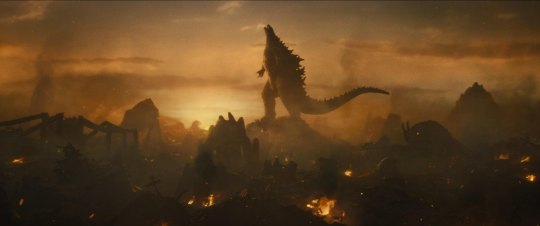
Director Michael Dougherty amply demonstrates his credentials as a Godzilla fan in bringing to the screen a film that lovingly references myriad aspects of the various Toho series since 1954. This lavish and detailed homage to the legacy of Godzilla is full of nods that aficionados will find delicious and our favorite daikaiju have never looked more conscious and gloriously alive. It is crafted in an American summer blockbuster style in its breathless pacing so that one has to be quite sharp to spot all the goodies he’s woven into this third episode of Legendary’s MONSTERVERSE. While Gareth Edwards’ 2014 GODZILLA employed a Spielbergian touch, Dougherty offers the most Toho-esque installment so far in this franchise.
Essence of Toho
In my review of the 2014 Edwards film, I had speculated that a MONARCH-centered approach would be best going forward, and indeed that has been the case with both KONG: SKULL ISLAND and this film. Dougherty has taken that Toho Showa series’ leap into “super science,” with defensive masers, secret bases around the globe enveloping recumbent daikaiju, and the ORCA device, meant to communicate with the Titans. This approach, sort of sci-fantasy, enlarges the sandbox in which he can play and recalls what has been part of so many prior Godzilla outings. MONARCH’s Argo, an immense flying wing, seems to echo the various “Super X” vehicles from the Heisei series, the Marvel Comics S.H.I.E.L.D. helicarrier Behemoth from their Godzilla: King of the Monsters series, as well as being a nod to both the flying wing from George Pal’s THE WAR OF THE WORLDS (the Northrop YB-49) and to the name of the ship from JASON AND THE ARGONAUTS, so well depicted by Ray Harryhausen. One particular delight for me was the Osprey’s arrival at the Castle Bravo facility, recalling the opening of DESTROY ALL MONSTERS, where a helicopter descended into a similar circular vertical tunnel to reach the hidden base on Monster Island. And, as Toho had done with its production design, these MONARCH scientific/military installations are full of gigantic screens surrounded by flashing lights from which “officially concerned” humans can monitor the global monster action at a safe distance.

Eggleton’s Impact
I was impressed by the painterly cinematography in this most Eggletonian-looking of Godzilla films—I actually expected to see Bob acknowledged in the credits as his visual style so permeates many scenes. Fans of his paintings cannot miss how much of the imagery is flavored by this extraordinary artist’s numerous works. That impressionistic sensibility Edwards had captured in the HALO descent to San Francisco scene infuses much of this movie. And his method for viewing the Titans from human perspectives to make their scale apparent was also deliberately maintained by Dougherty. Despite so much care having been lavished on the sweeping imagery, these sumptuous frames fly by in fractions of a second, which has sadly become the standard action film approach to editing and pacing. That for me is a disservice to those who clearly worked diligently to craft impressive and iconic visuals—such splendor should not be snatched away so swiftly from our hungry eyes. Lingering just a bit longer on some of these fantastic moments would have been so much more satisfying. When King Ghidorah seizes Rodan’s volcanic aerie and regenerates his missing head in a very bizarre, placental manner, his dominance over a foreground cross suggests his demonic power, much as FANTASIA’s Chernabog perched atop Mount Triglav—a gorgeous and potent symbol. He then sends out a call to rouse the world’s Titans to do his bidding as their “usurper king.” That pivotal moment passes far too quickly. Would that the two flanking heads have paused and then looked to the central dominant head, who would return their gazes, then look skyward and begin voicing “the call.” Then the other two would join-in, very deliberately, with some unearthly new sound reaching out to be that irresistible global conscription summons. That could have kicked the scene up significantly. The triple voiced sound used in the film was less of a command, rather a sort of keening, which quietly lingered in the following scenes of the other Titans awakening. For my tastes it should have had more of a dramatic emphasis—and have been audibly unique to the moment. Even somehow having King Ghidorah take note of his new troops as they each arise and perhaps respond audibly to his summons would have made his dominance much clearer and more exciting—perhaps cutting back to him as his heads express a knowledge of each new disciple’s activation?
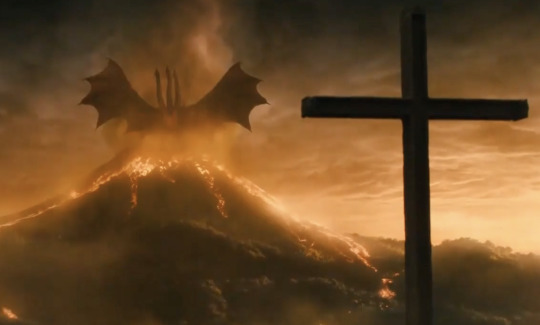
Daikaiju Design
The designs of the quartet of classic Toho stars move to the top of my favorites, as each are detailed, expressive, and dynamic. Tweaking Godzilla’s look to enlarge his dorsal plates and having them flicker even when not powering up for a blast of nuclear plasma works well—he crackles with latent energy. While the 2014 look is an excellent, naturalistic one, changing the primary row of dorsal plates to repeat the 1954 design and then bumping up the secondary rows to Heisei-styled size makes him more in line with earlier Gozilla incarnations. I’d still like him to sport a proper tertiary row of plates that are clearly defined, which has been a common aspect of many incarnations of the King of the Monsters. Taking those sauropod-esque feet and enlarging the claws for more of a predatory aspect looks fearsome, and I like the shortening of the whip tail of the 2014 version to be more like the standard Godzilla profile. And having a new climactic revival of “Burning Godzilla” was a fine choice, reigniting that concept from GODZILLA VS. DESTOROYAH. King Ghidorah is masterfully realized, a proud successor to DRAGONSLAYER’s Vermithrax Pejorative, who can fly, stride or wing-walk with sinuous beauty. That aspects of his wings echo a William Blake image of the Red Dragon really makes for such resonance. The three heads being somewhat independent with unique personalities was also a superb concept. Ghidorah’s condescending curiosity regarding those nasty, puny humans he was seeing for the first time—even to licking their corpses to explore them—brought forth his diabolically sinister consciousness. His gravity beams and the neck-glow charge-up are splendid. Mothra in her bioluminescent glory is stunningly conceived, from impressively carapaced larva to majestic moth-mantis-wasp imago—magnificent, mysterious, and with a feminine puissance. Rodan as the fantasy firebird, a magma-veined pterosaur, fiendishly skeksis-esque in angry avian awareness, has such presence. Bowing like a courtier to both the usurper and finally to the true king, he exhibits a calculating, conscious persona. His thrilling barrel-roll to take out the pursuing jets was about the most spectacular image we’ve seen of him, ever.
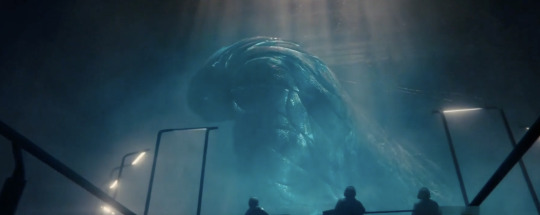
As Toho had done in SHIN GOJIRA, Godzilla’s roars from the various series were employed, as well as his roars from the 2014 film. I was hoping for more of the very deep vocalizations from the 1954 original. Mothra sounded as she always has, with plaintive chirrups and screes. The cries for both Rodan and King Ghidorah were not the originals, and were for me a bit more “generic giant monster” voices. I would have loved to hear new recreations of those readily recognizable Rodan yawps and cackles, and much more forward versions of KG’s triple toned “bidi-bidi-bidi” voice—rather than the faint references buried in the raucous sound design. I rather expected more original Toho monster sounds than were used for both of them, since Daugherty was employing past iconic sounds for both Godzilla and Mothra and seemed to be teasing that during the film’s production.
A Grim Setting
While there is some humor—not all of it apt— intended to break tension, the plot of this film builds upon the global revelation to the people of Earth that past super species were essentially their “gods,” knocking present day humans down a few notches on the dominance pyramid. The context is alarm and terror, though the MONSTERVERSE also offers awe and wonder as viewed through some of those studying the returning Titans. Serizawa remarks in a senate hearing that humanity should be viewed as Godzilla’s “pets”—and he means it. He respects “all forms of life” and sees our world as one that must have a balance which is inclusive of its natural organisms, regardless of where we might end up in Nature’s organic tapestry. Over the course of the film, much is learned about the fascinating past history of human societies who lived in harmony with the Titans. Toho implied some of this in their films—Mothra was regularly portrayed as an eternal goddess for the islanders she protected—but here it is made quite explicit and detailed. Godzilla’s temple lair in submerged Atlantis, with gigantic friezes and sculptures honoring him, is surely an enrichment of this ongoing saga. There is a dark side to this scenario wherein some see humans as being abusive to their world and thus in need of being forcibly “tamed,” and then there is the collective might of the military who want to subjugate these creatures and restore man’s preeminence—behavior that began in the original GOJIRA and sustained throughout most of the films.
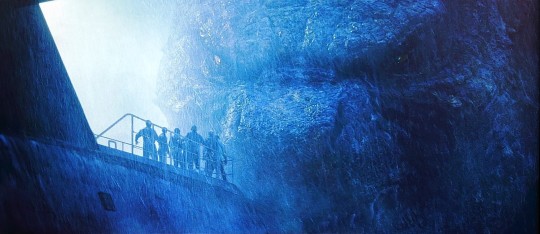
Dr. Emma Russell is an oddly polarized primary character. To begin, she seems a concerned mother who has rescued her daughter Madison from her husband’s descent into alcoholism, which had been incited by the death of their son Andrew during Godzilla’s San Francisco battle with the Muto’s. An aside: That plot aspect is reminiscent of a similar character motivation in the third of Kaneko’s Gamera trilogy, wherein a young girl’s commitment to invoking the destructive daikaiju Iris is sealed by her parents’ collateral death during a monster rampage in the first film where Gamera, an Earth defender, destroys his adversary Gyaos. That Emma is no “mother of the year” is quickly exposed when Allan Jonah’s eco-terrorists arrive to snatch she and her daughter (and her Titan controlling ORCA device) after they execute the innocent MONARCH crew studying Titanus Mosura. Emma has indoctrinated her daughter to comply with her pursuit of shattering mankind’s toxic presence by releasing the Titans as “antibodies” to the virus that is human kind. And Emma is in cahoots with these extremists, her obsession being the first cause setting in motion the slaughter of her MONARCH colleagues in China, Antarctica, and Mexico as well as the other locations wherein the Titans are roused to destroy their containment facilities. And countless others then perish around the globe as the revived Titans rage. The script makes her somewhat sympathetic as a mother—she is shown to love and be concerned with her daughter and mournful of her son—but one could not give her a pass for the oceans of blood on her hands. Nor should she be forgiven for making Madison a victim of Stockholm syndrome. Madison, comprehending the grievous practices kindled by her mother’s theories, does awaken to reject Emma’s deeds and then she strives at great risk to use the ORCA to solve the global catastrophe wrought by both Emma and Jonah’s fanaticism. There is a cut scene in the video release of Madison training with the eco-terrorists which would have underlined her submission to her situation—I would have included that for the parallel with Patty Hearst it presents. Madison ultimately is heroic, and her father Mark renews himself by stepping-up to guide MONARCH’s efforts to understand and control the Titans. He provides some crucial insights based on his knowledge of animal hierarchy and behavior. Ultimately, Emma seeks atonement through her sacrifice, which brings some justice to her character’s story, while Mark and Madison are reunited in a world reeling from cataclysmic destruction. A rather “heavy” arc to this family’s journey, and properly symbolic in dealing with present social concerns. I think that it seemed to be missed by many viewers who were more concerned with the pyrotechnics of the battling Titans, but for me it is a properly grounded human story which offers a grave context to the monster spectacles.

Homages A Plenty
There are so very many references in this film, both visually and via dialogue—“Easter eggs” abound! I’ll touch upon a very few, leaving exhaustingly listing them to other obsessive fans. I enjoyed the numbered MONARCH outposts having significance—the release year of the film in which the Toho daikaiju there contained was a delight and also the fun nod to THE THING in the Antarctica outpost numerical designation. Modernizing the Shobijin by having Doctors Chen and Ling, and generations of twins in their family, as “priestesses” of Mothra is an excellent touch. The new Titans are gleeful references to mythology and cryptozoology, demonstrating that many cultures have embraced daikaiju throughout history. Intriguing archaeological mysteries are touched upon such as 12,000 year old Göbekli Tepe, hinting at past humans dealings with Titans. Even an article in the jam-packed end titles is authored by Steve Martin, the character played by Raymond Burr in the American version of the 1954 film which was first to be titled GODZILLA, KING OF THE MONSTERS.
MONARCH’s mission critical submarine is named USS Scorpion, after an American nuclear submarine which was lost under mysterious circumstances, and it has a Captain Crane, like The Seaview in VOYAGE TO THE BOTTOM OF THE SEA. Its conning tower likewise has Seaview-esque planes and shape. The skeleton of Anguirus has a cameo, briefly glimpsed outside of Godzilla’s temple lair, and if only we’d gotten a better look at more of the Atlantean art paying homage to Godzilla—there seem to be monumental figures with Godzilla heads atop humanoid bodies holding some sort of ceremonial weapons which Serizawa passes on his way to revive his “old friend.” A sculpture of Pazuzu is glimpsed atop a step pyramid in that lost city—such artifacts all sadly obliterated to revive Godzilla. Some more time to drink in this elaborately detailed majestic setting would have been appreciated.
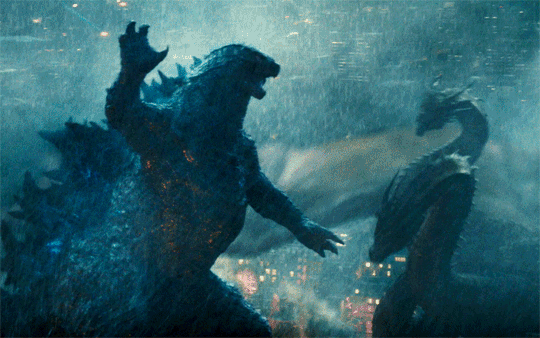
Several key plot events here are reshufflings from past Godzilla films. The concept of one daikaiju sacrificing itself to revive another was pivotal in GODZILLA VS. MECHAGODZILLA 2. There, Godzilla is tortured to near death by electrodes from Mechagodzilla which pierced his body and fried his secondary enlarged ganglial areas. Fire Rodan, nearly expired from his conflict with Mechagodzilla, as a dying act drapes himself atop the fallen Godzilla, evaporating into a sparkling mist and then both healing and resurrecting Godzilla, who now has an even more powerful, red-tinged plasma beam. In GMK, Godzilla is the “heel” who fights the more positive trio of Baragon, Mothra and King Ghidorah. Godzilla seemingly kills King Ghidorah, so Mothra makes a direct, suicidal flight at Godzilla who evaporates her with his plasma breath—shared imagery with Daugherty’s film, though here King Ghidorah and Godzilla have reversed roles. In Kaneko’s film, Mothra’s energy descends upon King Ghidorah in a sparkling cloud, reviving him and enhancing his wings and gravity beams for the final combat with Godzilla. That Godzilla thrives on exposure to radiation has long been part of the basic lore of many of the films, and his revival and enhancement through extreme exposure was no surprise as being primary to the MONSTERVERSE’s mythology. And the scene wherein King Ghidorah “powers-up” via biting electrical cables in the Boston battle reminds me of Kong being electrically revived in the original KING KONG VS. GODZILLA. Godzilla’s expression as King Ghidorah takes that bite, and then the massive arcs of electricity that spread out from his wings to clear the attacking human’s jets are both such memorable moments—which could have been given just a bit more time to accommodate earned “oohs and aahs.”

The novelization of GODZILLA: KING OF THE MONSTERS goes into detail about some of the Titans only glimpsed or simply listed in the film, and one hopes they’ll emerge in the next or further MONSTERVERSE installments—if any. There is a beautiful, brief passage in the book which is told from Godzilla’s point of view. We see through his eyes his responsibility as the lord and protector of this world—the globe is his domain and he is aware of the entire planet, sensing time passing through the shifts in Earth’s tectonic plates. He is aware of the much younger Kong, but unconcerned as Kong is only responsible for Skull Island. We know Kong is the last of his kind, and Godzilla also seems to be as well, though in the comic prequel to this film the story of the Godzilla-esque skeleton infested with the two Muto spores was explained as being Dagon—perhaps his elder “cousin”? The Muto which killed him was vanquished by Godzilla between the 2014 and 2019 films in that comic, which also serves to explain the change in his dorsal plates, which Dougherty has said are continually growing, like antlers. It would be a delight if the Kraken, snoozing as it embraces a sunken nuclear submarine, and Mokele-Mbembe, designed according to the legends as part serpent and elephant, had scenes in the films to come. If Godzilla at some point must sacrifice himself to save the world, discovering another younger member of his species in the Hollow Earth regions would not be surprising and would also embrace that “son of Godzilla” concept used in Toho’s series. The sunken Atlantis being part of the subterranean world evokes Verne’s JOURNEY TO THE CENTER OF THE EARTH, and of course the 1959 film adaptation concludes with a gigantic lizard menacing the remains of the Lindenbrook party in its ruins. Perhaps there are other humans (humanoids) “down below” as well, in fascinating antediluvian cities, much as Toho posited with the Seatopians, or even like the subterranean Sumerians from THE MOLE PEOPLE? Possibilities abound!
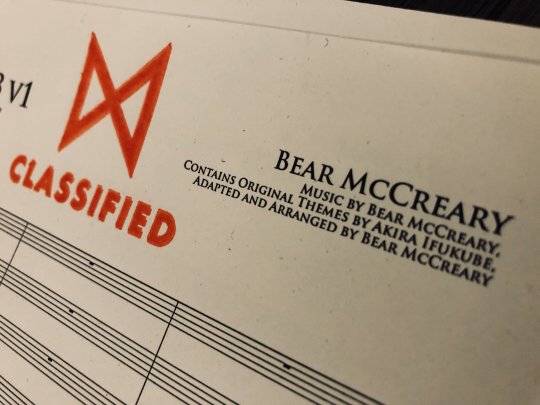
The Score
We’ve been quite fortunate that the scores for Hollywood Godzilla films have been powerful, thematic, and thoughtfully composed works wrought by talented composers. Both Arnold and Desplat crafted magnificent music that expressively carried the action. McCreary’s is the first MONSTERVERSE score to incorporate iconic themes for both Godzilla and Mothra from the Toho scores, and these quotations were well-timed and heightened the drama. Additionally, his new themes are both strong and memorable. The thematic material for King Ghidorah constantly iterates the number three, and the general rising melodic line is even kin to that of Holst’s “Mars, The Bringer of War” from THE PLANETS. The chanting monks’ voices offer a mysterious sense of religious awe to support the diabolical “destroyer of worlds.” Rodan’s theme features whooping horns, as if to echo the “Samurai of the Skies” cries. Even the film’s opening quiet theme has that “Go-Ji-Ra” rhythm that was used in both the 1998 and 2014 films to craft memorable new musical signatures for the King of the Monsters. Most touching was the gorgeous choral music accompanying Serizawa’s Spock-esque sacrifice—which even visually rhymed the descent of the mini-sub with the photon torpedo casket sequence from THE WRATH OF KHAN. The MONSTERVERSE’s Serizawa is essentially a transmogrified Dr. Yamane from the 1954 GOJIRA, a man who studies and appreciates Godzilla as a living being. By having him sacrifice himself not to destroy Earth’s dominant Titan, but to revive him with a nuclear weapon and thus save humanity, works as a pragmatic inverse linking him to the original Dr. Seizawa, the self-immolating physicist who conceived of far too deadly a weapon in the Oxygen Destroyer. McCreary’s “requiem” suited that sequence to perfection. When Godzilla rises again and blasts forth his plasma beam into the sky, the Ifukube-based accompaniment was deeply moving, and the moment Godzilla looked to his human saviors was delightful. He seems to acknowledge their role, much as that of the people from a past civilization who had idolized him, and the soundtrack even has a fleeting phrase of Ifukube’s Godzilla theme much as it was scored for high woodwinds in the requiem from GODZILLA VS. DESTOROYAH—a very brief and subtle nod. McCreary’s triumphant symphonic apotheosis of his own opening Go-ji-ra theme over that concluding acknowledgment of the Earth’s true monarch brought me chills. Being followed immediately by McCreary’s magnificently over-the-top arrangement of B.O.C.’s song “Godzilla” to commence the end titles was fan service of the highest order. Its refrain, “History shows again and again how nature points out the folly of man!” is of course the underlying theme of the Legendary MONSTERVERSE. “Bravo!” Maestro McCreary!

Could Be Bettered
Some minor cavils. I prefer to hear the word Ghidorah pronounced in the more euphonious Japanese manner, with the three syllables (ghi-do-rah) given equal emphasis and the first one slightly higher in pitch. One can hear it when watching Toho’s original Japanese prints with English subtitles. Americans emphasize the second syllable (Ghi-DOR-ah), and thus the middle one sounds like the English word door, while the Japanese put the R on the third syllable. I’d have dropped that weak gonorrhea joke, and the “very long fortune cookie” line was a tad clumsy, and a bit out of place for the dignified Serizawa. In this film he seems to take a bit of a back seat to Dr. Mark Russell, once he’s on the scene, which is a bit of a disservice to his character for me. And that his sidekick Dr. Graham is so quickly dispatched by King Ghidorah during his emergence seemed a bit too casual—her character was a fine one, and I’d have enjoyed more from her going forward.
The film brings back the Oxygen Destroyer, a wonderful nod to the original, and they hint at it being tested in the news crawl Madison and Emma have on in the background in their opening domestic scene at the China base. The news commentator’s reporting of “mass die-offs” must be from the military testing it. Rather than having it come as a surprise announcement when the incoming missile is announced by Admiral Stenz, I think that viewers should have been clued-in earlier, and rather easily. The audience primarily sees things from the point of view of the MONARCH characters. But if we go to that senate hearing scene, from which the MONARCH crew departs having been alerted to the eco-terrorist attack on their Mothra temple base—despite being warned that there will be consequences, that scene could have briefly continued. Admiral Stenz would reveal to the committee, once Serizawa and crew have departed, that the military now has a prototype weapon that they think could be used to exterminate the Titans. We’d cut from the blurred footage of the Mutos on the monitor to a graphic of the Oxygen Destroyer (what we saw later when Stenz alerts the Argo team), while Stenz declares this is their tested proposal for conquering the Titans. If one wanted to flesh it out, then perhaps running some brief footage of it killing fish or other forms of life with some dark accompanying music would be a strong punctuation. But even that wouldn’t be required, just that graphic and a Stenz voiceover would have done the trick. So, rather than ending on a weak joke about blurred Titan genitals, we’d have the Oxygen Destroyer’s revelation as added tension for its eventual use.
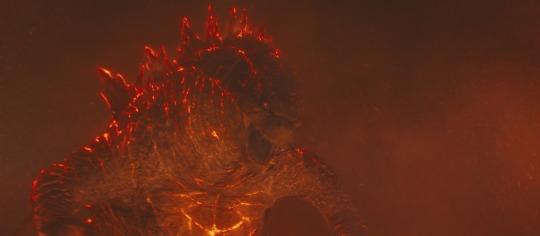
With such wonderfully detailed renditions of the Titans, particularly the four Toho guest stars, I think they went a bit too far in trying to fit them into their environments by surrounding them with clouds, mists, and fog. This gives the Titan scenes an overall soft and painterly feel, and I can enjoy that aesthetic choice, but seeing the creatures that were so very carefully designed, and whose movements are crafted in such a convincing manner, being obscured far too often I think was an error. Dialing that back somewhat would have been a wiser choice—show us what you’ve got! Particularly in the expert choreography of the battling Titans—which in some scenes appears to have been inspired by Matt Frank’s compositional style—being able to see how the tussles and tumbles progress with greater clarity would have enhanced the viewing experience.
Wishful Thinking
I would hope that there might eventually be a “director’s cut” in some future boxed-set home video release of the MONSTERVERSE films that would relax the pace of this film somewhat—taking time to linger on the beautifully crafted images so that we won’t have to freeze-frame to savor the glories on screen. And the storyboarded but unfilmed mid-credit scene of another Mothra egg being sung to by twin young girls in another hidden temple space beneath a modern city should be added-in or at least exist as part of the extras—possibly an animated version? If the box office returns from the next installment don’t justify further live action films, it would be fun to have a MONARCH-centered animated series exploring the numerous Titans and how humanity must deal with them. The cartoon series that followed the 1998 Emmerich GODZILLA film was quite an improvement over its progenitor, so I suspect something similar could happen with this franchise going forward once live action films are no longer produced.

The Coming Conflict
Daugherty has reportedly had some plot input towards Wingard’s upcoming GODZILLA VS. KONG, and so the end titles give us glimpses into what might be to come via various briefly shown illustrated articles. One explains that the newly emerged Titans were being drawn to Skull Island, so one has to wonder if that locale could at the conclusion become the “Monster Island” of the MONSTERVERSE? That it is a gateway to the Hollow Earth is an exciting prospect, for more mysteries abound there. Already the rumor that the APEX corporation, which funded Colonel Alan Jonah’s eco-terrorists, is now behind the construction of Mechagodzilla (the toys of this character have been leaked already), who will have an ORCA variant built-in to lure Titans to the slaughter.
King Ghidorah can regenerate in an unearthly manner and the director has mentioned in interviews that his consciousness is spread through his body. Daugherty has said that whatever might have fed on the carcass head could perhaps become some sort of mutating “legion,” perpetuating King Ghidorah, from flies to any sea creatures that took a nibble, if the series goes on. The rumor mill suggests that materials from the brain of this dead head have been used to create a bio-tech controller to enhance Mechagodzilla. Now that we’ve gone to a Showa series sensibility, the film makers have a great deal of latitude for referencing some of the more fantastic concepts from earlier films. With the biggest blockbusters today being super hero fantasies, one need not try to pretend that MONSTERVERSE films are bounded by the laws of our Universe. The relatively more “realist” approach of Edwards’ 2014 GODZILLA has been evolved into a broadly fantastic approach, which reflects much of what Toho had done in all of its series.
Fan Reactions
It seems some Godzilla fans on message boards are now turning on Dougherty’s epic—everyone seems to want each new film to be their vision of the perfect Godzilla film and then disappointment sets in when it isn’t. Yet so many of the films throughout the ongoing saga of Godzilla have been silly, cheesy, daffy, and sometimes just dopey—yet many of we aficionados embrace them all for their charms, after all, we get to see more of Godzilla and his fellow daikaiju. They appeal to quite a wide range of viewers of all ages, and as one ages, different films might head a favorites list based on one’s evolving tastes. Better that more Godzilla tales are wrought and released, regardless of whatever flaws we might find. In GODZILLA: KING OF THE MONSTERS the incarnations of our old favorites and some intriguing new Titans are truly extraordinary, brought to vivid life with contemporary effects capabilities. Never before have these sorts of films been graced with such mammoth budgets and been seen by such large audiences around the globe—a golden age for Godzilla is upon us.
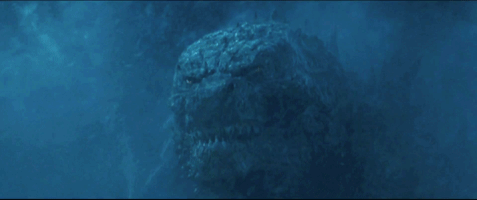
Huzzah Daugherty!
Despite its flaws, I find so much to love in this film, particularly that final scene. After Godzilla has vaporized his age-old rival and literally “smoked” his final head, the Titans summoned by Madison’s activation of the ORCA in Fenway Park arrive. Godzilla, battered and weary from his strivings has exhausted the energy gifted to him through his ally Mothra’s sacrifice—like Heracles after his many labors. This unbowed victor is at last confronted by the other awakened super-species. It looks like a further battle could ensue, as Rodan swoops down at last. But, that canny firebird knows his place and thus submits to the true king, with a nod and almost a courtsey-like gesture of his cape-like wings. The other Titans then “bend the knee” and Godzilla bellows his triumphant “skreeonk” as McCreary’s music superbly supports this coronation scene. I felt such a powerful frisson at that moment and do with each repeat viewing. The Titans demonstrate their consciousness, intelligence, and their sense of natural hierarchy in what is one of my favorite conclusions in the entire canon of Godzilla films.
So, I salute Daugherty and all the others involved in what for me is a grand outing for all of the Titans and a very fine addition to the roster of Godzilla’s adventures. I’ve watched it many times since I saw that first Thursday night preview screening, and I continue to enjoy it immensely. Like all of the earlier films, I don’t dwell on what I see as flaws, but I celebrate the unique wonders that have been wrought, and these abound in this Toho-redolent GODZILLA: KING OF THE MONSTERS.
The bar has been raised. Batter-up, Adam Wingard—let the MONSTERVERSE continue!
—Peter H. Gilmore
19 notes
·
View notes
Text
A Review of IP Man 3 (2010)
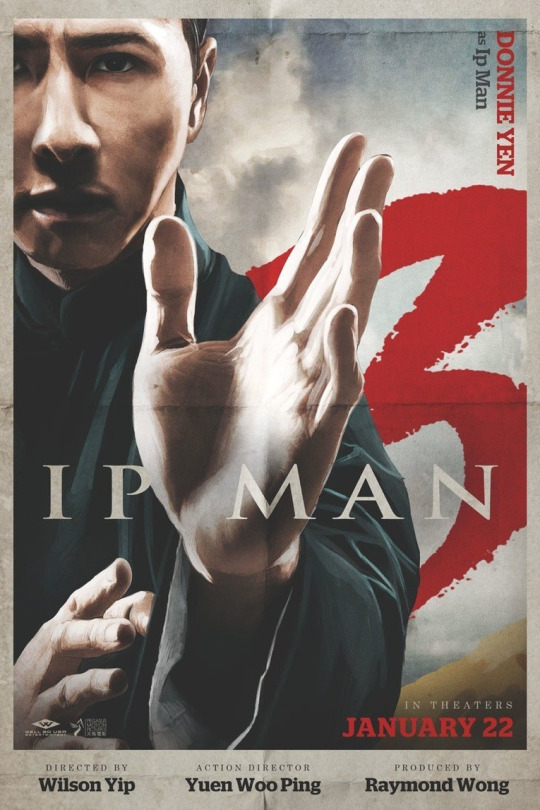
When I first watched this movie, I remember not liking it and feeling rather disappointed with it which is the opposite of how I felt when I watched IP Man 2. However, after re-watching this movie I came out rather appreciating it and enjoying it way more than I expected.
Sammo Hung who was the action director of the first two IP Man film does not return for the third one. Instead, IP Man 3 has Woo-Ping Yuen as the new action director who has a lot of martial art movies to his belt such as Kung fu Hustle and Kill Bill so the action was still in safe hands. One of the things I felt about IP Man 2 that was rather off-putting was the very cartoony style of fighting and overuse of wire works. I can safely say that in IP Man 3 it returns to the more grounded and realistic style of the first movie.
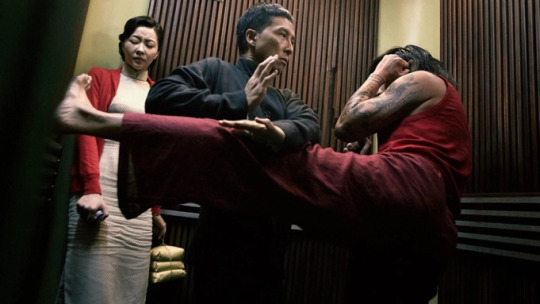
This movie also expands upon the use of environments for the action scenes. Ip Man fights a dozen men on a stair, fights in a construction area and fights a Muay Thai boxer in a claustrophobic elevator. Rather than just be open areas like the first movie, this movie incorporates different environments to create very unique fight scenes. For example, IP Man uses the hand rails during the stair fight or having him protect his wife during the conflict within the small area of the elevator. It's very creative and also very exhilarating fight scenes. One of the biggest advertisement for this movie was IP Man's fight against Frank played by Mike Tyson and despite being just 3 minutes, the fight is still really amazing. While in IP Man 1 he was invincible and there was no threat in the fights and in IP Man 2 where he actually fought physically struggling fights, IP Man 3 does something different. IP Man is still rather invincible in the fights but its the meaning to these fights that are the real suspense. It's a very interesting way of keeping IP Man as the all-mighty superhero but still, make it seem like he is genuinely in trouble in these fights.
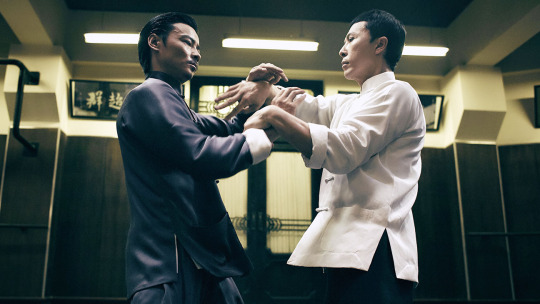
There is also a very interesting rival and antagonist for IP Man in Zhang Jin as Cheung Tin-chi who is also a Wing Chun user. It's not like a lot of the movies in which the antagonist is like the main character but evil, Cheung Tin has a lot of depth to him. He will protect innocent people like IP Man and has someone he cares about but is a lot more aggressive compared to IP Man. Zhang Jin and the action director manages to show this contrast by having IP Man fight with more elegance whereas Cheung Tin with more ferocity even though they use the same fighting style. Cheung Tin is also very sympathetic in that he doesn't get the same respect and recognition as IP Man even when he does a good deed and it plays a part in his jealousy towards IP Man which eventually builds up to an awesome climax fight scene. He is a very interesting character and it is no surprise that he eventually gets his own spinoff movie.
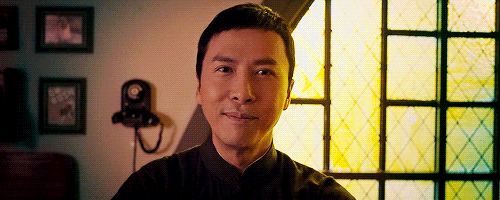
Ip Man himself still manages to get his own character arc in this movie in which the major focus is his relationship with his wife Cheung Wing-sing (Lynn Hung). IP Man throughout the first two movies was mostly calm, modest and restraint but in this movie, we get to see more emotions from him as he has a vastly different struggle compared to the previous two movies. In IP Man 1 he struggled with surviving WWII and in the second movie, he struggled with adapting and physically struggled in fights. In IP Man 3 the struggle is mostly dealing with his fame and his wife's cancer. Unlike the second film where there is a problem, he can fight directly, in IP Man 3 the problem can't be solved by fighting. It gives IP Man a unique character arc in which he doesn't come out by the end of the movie better than before but gaining a new perspective and lesson on what is most important in life. It's why I really enjoyed the second half of this movie with its more emotional scenes which is praise given to Donnie Yen for giving a great performance in these heart wrenching moments.
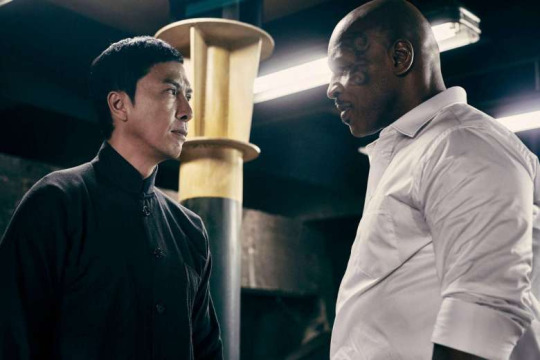
While the second half was great, the first half is not so much. The first half is about dealing with a triad gang working for the antagonist Frank played by Mike Tyson. Firstly, Mike Tyson is not an actor and it really shows in his really cheesy performance. It's even more gear grinding when they make him speak Cantonese and it is just really bad. Secondly, his character is never really explored even though he is the main antagonist for the first half. They don't explain his origins or his motivations whatsoever. It gets really dumb when this whole gang fiasco gets magically resolved somehow by IP Man engaging in a fistfight with Frank which contrasts the whole theme of the second half. It doesn't make any sense but it all just gets resolved and brushed under the rug with no one ever talking about it at all in the second half.
There is also this plot thread about Tsui Lik (Louis Cheung) who is a student of IP Man who has feelings for this school teacher which amounts to nothing. It doesn't add anything to the overall narrative but somehow was put in the movie to just pad time. His relationship with IP Man isn't even explored. The plot is stitched together poorly with a bunch of different plot lines somehow all connecting. Cheung's jealously, Triad leader being a student of some martial art master, police corruption, foreigners being in control, Frank in general, Ip Man's wife, Tsui Lik crush are all stitched together in the first half to create a very messy plot which just doesn't work. Thankfully the second half is more focused and consistent.
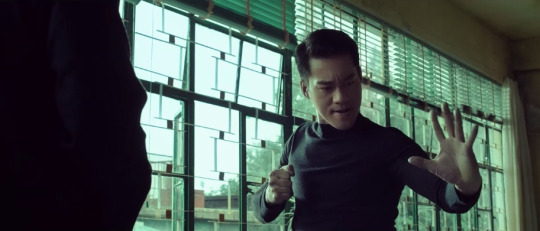
I also have a little nitpick with how unconnected this movie feels to its prequels. Ip Man's friend and previously bandit but now fisherman friend is nowhere to be seen or mentioned at all in this movie even though it is still set in Hong Kong. There are returning characters such as Fat Po (Kent Cheng ) who has relative importance and Master Law (Lo Mang) who is just a cameo. However, everyone else feels completely different such as the reporters and Tin Ngo-san (Bryan Leung) who is a martial art master with a great and long friendship with IP Man but who wasn't in previous movies so it just feels really weird. IP Man 2 showed how difficult it is to be martial art master in Hong Kong but I guess its all easier now or something since Cheung Tin seems to be able to start one with ease. One of the things I loved from the second movie was his relationship with Leung, his first student, but sadly he is nowhere to be seen or mentioned and is instead replaced with a forgettable character Tsui Lik who does nothing for the movie. Bruce Lee (Danny Chan) is in the movie but mostly as a cameo for how Ip Man ends up teaching him rather than exploring their relationship which is a shame.
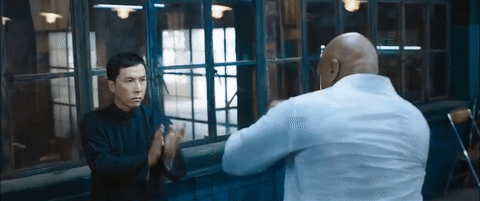
Overall, I still enjoyed this movie a lot. A majority of the problem with this movie is, unfortunately, all in the first 50 minutes but the second half is masterfully done that I almost forgive it. Even in the messy first half, the fights are still exciting and thrilling to watch. This is a good martial art movie and was a very satisfying conclusion to the IP Man saga before they decided to make one more. I enjoyed it more than I expected and the fact it took risk is something I can appreciate. It's not as bad as many say it is and I think there is a lot of good in it.

2 notes
·
View notes
Text
Honest Feels (James Gunn)
I feel something should be said about this.
As an avid supporter of the MCU and the Guardians of the Galaxy franchise, I have an incredible amount of respect for the studio and what they’ve done. James Gunn had an incredible vision of this vivid world of broken characters that he masterfully put on the screen. As a director and story teller, I couldn’t respect James Gunn more. Separate the art, from the artist.
I fully disagree with all of the “jokes” stated on his twitter feed. They are indefensible and blantently attempting to cause the reaction they have received, shock.
A key point many seem to over look is how these tweets are nearly ten years old. People are allowed to grow and change. If someone can forever be defined by a singular mistake, then no one would ever be good. Mistakes happen, people can slip up and do something stupid. What truly matters is how they can change from it.
The bandwagon of hate towards him as if he had actually committed these actions is also blatantly incorrect. There is a huge difference between saying something, and doing something.
From the business perspective I can understand why Disney was so quick to fire James Gunn. They need to protect face. Seeing a man’s life and lively hood destroyed because of a mistake he had made and apologized for in the past, is heart breaking to me.
I fully agree with the cast of Guardians, firing him so abruptly was the wrong call. Don’t let mistakes define people, let them grow.
85 notes
·
View notes
Text
Some sci-fi podcast recommendations
As an aspiring scientist and just general nerdy person, I love the sci-fi genre dearly. But tbqh, I find myself loving the genre itself and its concepts rather than the actual stories and media. I find that a good deal of sci-fi stories are written exclusively for, about, and from the perspectives of Cis Het White Men™, which I as a queer Filipino cannot relate to at all. I find it Bothersome that so many stories set in the future erase people like me. And I think that so many of these stories are so emotionally dull and lifeless as they tend to focus on the world and concepts at the detriment of fleshing out characters.
However, I think that mostly applies to mainstream sci-fi, because a lot of sci-fi podcasts are really diverse and inclusive. And I find that podcasts are often a written with a lot more character and emotional depth. I saw someone describe podcasts as being like fanfic cuz of how they are mostly character driven instead of plot driven.
Anyways, here’s my list of sci-fi podcast recommendations with descriptions and my personal thoughts. In no particular order, but I put the smaller ones first cuz i think they deserve more love.The ones with * are the ones with good queer rep (so far, it’ll be updated as needed).
Tides Podcast: It follows biologist Dr. Winifred Eurus, a member of the first manned expedition to Fons, an Earth-like moon wracked by extreme tidal waves due to its orbit around a nearby gas giant. When surveying ocean life her submarine is destroyed, leaving her alone to walk to higher ground before the wave comes back. Along the way, she makes notes about what she finds in the intertidal zone, and gradually realizes that some of the life there is more than what it seems. There’s only one episode out at the time of writing and I’m already deeply in love with this show. The main character is a huge lovable nerd. And in the space of one episode they’ve managed to create a creative, immersive and beautifully detailed alien world. If you’re really into biology like me, I think you’ll love this show.
Girl in Space: Abandoned on a dying ship in the farthest reaches of known space, a young scientist fights for survival (and patience with the on-board A.I.). Who is she? No one knows. But a lot of dangerous entities really want to find out. This show hooked me from the get-go cuz its atmosphere and setting are grippingly ominous and mysterious. It had me begging for more. The creepy vibes are balanced really well with the titular girl in space because she’s really likable and her ramblings can be really insightful and enlightening, but also really hilarious and relatable.
Empty*: The crew of an intergalactic colonization vessel wake up from cryosleep with no memories, finding themselves the only sentient life in the universe. Like Girl in Space, it has a masterfully done ominous atmosphere and world building that leaves you begging for more. But it has a wholly different tone because it feels grittier and serious. If you like creepy and slightly unsettling space podcasts, like Wolf 359, you should check this out. I can best describe this as space gothic, the same way Alice Isn’t Dead is American gothic. This podcast also uses a lot of hard sci-fi concepts in its worldbuilding, moreso that any podcasts I’ve listened to before.
The Earth Collective: Joseph Crane attempts to record and document the life and culture of the titular Earth Collective: the dying remnants of humanity living on rolling cities on the planet of Oasus, fleeing the malevolent entity known as the Dark This is one of my fave sci-fi podcasts ever. I’ve already gone on so much in this list about atmosphere and world building, but podcasts are just really good at that, and this one especially. The world building in this one is immersive and it feels so real, especially since I love learning about history and culture. Think of this show as Titan A.E but Soft™. It starts slow but it builds up the conflict and tension which fit really well with the atmosphere.
The Falcon Banner*: Two hundred years after the fall of the Terran Empire, humans find themselves the subject race of the alien Amsus Hegemony. Darien Taine, a police inspector for the Terran police kills an Amsus inquisitor in self-defense, a crime punishable by death. He escapes Earth, and finds himself embroiled in a resistance movement and a centuries old plot that shattered the empire. An audio theater dramatization of the novel by Christopher Patrick Lydon. This show is what would happen if someone looked at the original Star Wars trilogy and said, “Hmmm that was good but could be gayer.” This is a high production, high action, epic sci-fi space opera. This show captured my heart with a fascinating universe, well written characters, and a bombastic soundtrack and atmosphere. This is perhaps the most epic Gays in Space™ podcast I’ve listened to. But I feel like I should warn y’all, the series just ends with no conclusion, and it’s been a decade since. But the story continues on in a book series (the podcast adapts the first book).
The Strange Case of Starship Iris*: In 2189, Earth narrowly won a war against extraterrestrials. Two years later, in a distant patch of space, a mysterious explosion kills nearly the entire crew of the science vessel Starship Iris. The only survivor is Violet Liu, an intrepid, sarcastic, terrified biologist. But as Violet struggles to readjust to life after the Iris, questions abound. Was that explosion really an accident? If not, just what is going on? And why does every answer seem to get more bizarre and more dangerous? If Violet and her newfound allies want to untangle the truth, they’ll need courage, brilliance, and luck - and honestly, a couple of drinks. This show shines in having a really well written and lovable set of diverse characters that play off each other really well. Add on top of that some fresh world building concepts and ideas that I haven’t seen done anywhere else. All in all they create an engaging and immersive story.
Inkwyrm*: Inkwyrm Magazine is an intergalactic fashion publication, bringing readers the newest looks from all over the universe. At the head of it all is Annie Inkwyrm, and directly behind her is Mella Sonder, AI caretaker and Annie’s PA. Along for the ride is an overzealous PR director, a perpetually unimpressed physician, and an AI that really needs to learn some ethics. One part sit-com, one part space opera. This show is my comfort podcast. It’s hilarious, cheesy in a good way, and gay which is what I need during such stressful times like now. The characters are likable and play off each other well. It’s mostly a comedy, but it does have it’s serious moments which are well done and hit close to home for me.
Limetown: Ten years ago, over three hundred men, women and children disappeared from a small town in Tennessee, never to be heard from again. American Public Radio reporter Lia Haddock asks the question once more, “What happened to the people of Limetown?” This was one of my first podcasts and it set my bar really damn high. The gripping story drags you in with interesting characters, mysteries and concepts. The pacing is really well done and you wouldn’t even notice how many episodes had gone by. This was a really beautifully done mystery and thriller
The Message*:The weekly reports and interviews from Nicky Tomalin, covering the decoding of a message from outer space received 70 years ago. Over the course of 8 episodes we get an inside ear on how a top team of cryptologists attempt to decipher, decode, and understand the alien message. This was also one of my first ever podcasts. Like Limetown, it has a heart stopping story that will drag you all over place. It set the bar really high too. You’ll be constantly gripped by the ever increasing stakes and tension that conclude on a high note.
Life After*: The 10 episode series follows Ross, a low level employee at the FBI, who spends his days conversing online with his wife Charlie – who died eight months ago. But the technology behind this digital resurrection leads Ross down a dangerous path that threatens his job, his own life, and maybe even the world. This was done by the same people as The Message and it’s just as emotionally intense and immersive as a thriller. But the subject matter is more relatable and hits closer to home, both in that they’re personal issues that a lot of people have to deal with, and it deals with technology that may soon be a thing in daily life. The show has a lot of interesting ideas regarding technology, morality, and personhood, which makes it hit harder for me. (note, it’s on the same feed as The Message)
Eos 10*: The lives two mal-adjusted doctors and their staff on the Alliance space station, EOS 10. Other characters include a hypochondriac deposed prince, an aggressively enthusiastic nurse, and a galactically hated terrorist whom is not what you’d expect. This was also one of my first podcasts. It’s also one of my comfort podcasts. I imagine it as what would happen if Star Trek was a sitcom about doctors. Despite being a sitcom, the wacky sounding characters have a lot of surprising emotional depth and deal with serious issues that makes them really lovable and relatable. They play off each other wonderfully, which makes the comedy and the plot in general hit harder. It has a lot of same vibes as Inkwyrm.
Ars Paradoxica*: When an experiment in a time much like our own goes horribly awry, Dr. Sally Grissom finds herself stranded in the past and entrenched in the activities of a clandestine branch of the US government. Grissom and her team quickly learn that there’s no safety net when toying with the fundamental logic of the universe. This really one of the most intense podcasts I’ve ever had the pleasure of listening to. The characters are all massively compelling disasters that will make you feel so many things. It has so many twists and wonderfully tragic time travel ideas and concepts. I’m not kidding when I say that this is the best show regarding time travel I’ve ever seen. As someone with a love of history and science, I love how hard they play up those elements. Physics ain’t my forte so I’m not sure but this feels like a very hard sci-fi.
Wolf 359: Set on board the U.S.S. Hephaestus space station, the dysfunctional crew deals with daily life-or-death emergencies, while searching for signs of alien life and discovering there might be more to their mission than they thought. Tune into your home away from home… seven and a half light years away from Earth… This is one of the most popular ones so I put it last, but no podcast rec list would be complete without Wolf 359. This isn’t just a show, it’s an experience, it’s a life changer. It’s one of the best pieces of art that you’ll ever see.While I do admit it take a bit before it finds its legs, but it gets indescribably good when it does. The characters are all wonderful disasters with a lot of emotional depth and development to them. The story is paced really well, it knows when to get intense and suspenseful. But it also knows when to put in breather episodes and to make the intense parts easier to process with well written comedy. And the plot is unpredictable and plays with a lot of tropes and cliches. But you won’t feel lost because it knows to set the atmosphere and foreshadow. This show is Chekhov’s machine gun.
The Bright Sessions*: follows a group of therapy patients. But these are not your typical patients - each has a unique supernatural ability. The show documents their struggles and discoveries as well as the motivations of their mysterious therapist, Dr. Bright. I’ve listened to a lot of podcasts in my life and I gotta say, this is the best one I’ve listened to so far. It’s very well written and well acted. This podcast will make you feel so much for the lovable characters and their struggles as they learn how to people while handling their powers. This show also isn’t just a show, it’s a masterpiece in storytelling that will change your life. Like Wolf 359, it hits hard in the feels department because of how much you’ll care for the multifaceted characters; but this one hits differently because the problems they encounter are one’s you’ll probably have to face yourself.
#wolf 359#the bright sessions#ars paradoxica#eos 10#times podcast#inkwyrm#girl in space#tscosi#the strange case of starship iris#limetown#the message#life after#tec#the earth collective#tino talks
2K notes
·
View notes
Photo
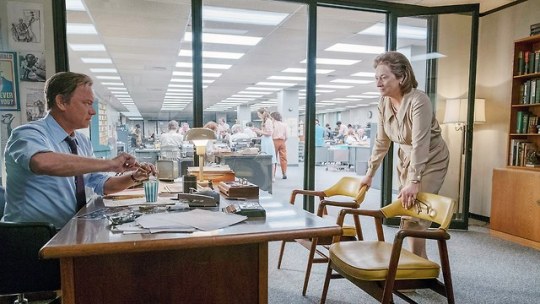
The First Rough Draft of History
(Review of ‘The Post’ seen on the 21st of February 2018)
Steven Spielberg is a productive director. His IMDb reveals no less than 57 Director credits. His latest, The Post, follows in slipstream of recent works, Lincoln and Bridge of Spies, in showcasing important, historical events in the relatively short history of the United States. This time it is not revolutionary leaders or spy exchanges that in the centre of events; in stead he know portrays a story of the free press that is so important to a modern democracy. As it is stated in the film: “The press is for the governed, not the governors!” As such the film has rarely seemed more relevant than it does today in the media presence of world leaders such as Trump and Putin alike. How far should the press go to reveal the truth and what should their relationship be to he leaders in charge? Those are the two central questions that Spielberg asks and answers with his most recent film.
It is the story of the Pentagon Papers and how these - confidential - papers were shared with the press at the height of Nixon’s presidency. We follow the newsroom crew at the Washington Post - at this time a local newspaper - as they observe the more prominent New York Times receive an indictment from the authorities as they publish a story based on the leak. When Post editor Ben Bradlee and his team finally gets a hold on the leaked papers, he and owner, Kay Graham (who have inherited the ownership from her late husband) faces the questions mentioned earlier as they are entangled in moral and ethical questions relating to personal relations, their journalistic oath, the disclosure of methodical government lies and injustices as well as the very future existence of the paper. As the papers threaten to uncover lies of not just Nixon’s administration but the three before him as well, the White House lures in a distance determined to prevent the publication…
At the centre of it all is a powerduo who remarkably stars in their first film together here: Meryl Streep as Kay Graham and Tom Hanks as Ben Bradlee. Hanks who is a Spielberg-usual (Bridge of Spies, The Terminal, Catch Me if you Can and Saving Private Ryan) delivers a well-balanced and convincing performance as Bradlee, who refuses to be bullied by neither the authorities or company big heads in his battle to uncover the truth. His performance bears many similarities to his turn in Bridge of Spies and it is hard to put a finger on it, although it is oddly anonymous at the same time.
Opposite of him, Spielberg first timer, Meryl Streep, is the films main asset as Kay Graham. Even though, I have an issue with Streep in the sense that I always see her in her characters (unlike Daniel Day-Lewis for instance) it is hard to look beyond her here and admittedly her Oscar nomination is one of her more well-deserved. She delivers one of her most nuanced performances in years as the insecure yet stubborn Graham, who faces a journalistic dilemma with the potential to change history without ever really having had her daily life in the newsroom or offices of the Post. Her character develops in a satisfying way throughout the film and despite a slightly overdone scene towards the end that highlights this in a blatant way, her character sure is a great role model and idol for women in leading jobs. In this way, the film becomes even more relevant in the 2018 political climate thanks to more than just its focus on the free press.
The supporting cast is great but also slightly forgettable; perhaps with the exception of Jesse Plemons’ legal advisor who provides an interesting and somewhat funny opposition to the stubborn journalists as he represents the harsh facts of the legal aspect of their otherwise heroic, journalistic mission. It is hard not to compare this film to recent journalistic portrayals as the one in Spotlight (2015); a film that was much more of an ensemble film. Make no mistake; here Meryl and Tom rule above all.
Despite its flaws in storytelling and character building (for the supporting roles), this is a master at work. Spielberg knows what he is doing and he masterfully manages to create not only a historically important film but also actual tension and suspense despite the fact that we know what happens. One great example of this is a scene in which all the important people are discussing whether or not to publish the papers. This is done over the phone, but obviously way before the age of conference calls. No, instead every single person stands in different places (some within the same house) with different telephones. A scene, which could so easily have been a scene of hopeless editing from one person to another, becomes a nail-biting and suspenseful scene in the hands of Spielberg. One of the best scenes in the entire film for sure.
With the score composed by living legend John Williams (his 143rd composer credit that is!!), Janusz Kaminski behind the camera with his ever observant eye and Michael Kahn (along with newcomer Sarah Broshar) in the editing room, this is Spielberg playing it safe. However, it is difficult to blame him for doing so when the result is such a well-functioning film finished in an unprecedented timeframe with just 9 months from finished script to final cut that hits right into the political climate of its time. That is a proof of not only a masterful filmmaker, but also a filmmaker who knows and acknowledges the power of the medium to promote and provide a perspective on current issues. Much like the press in the film, arts share the same possibility of commenting on and revealing truths.
4/5
#Film#Film Review#Movie#Movie Review#Oscars#Oscars 2018#academy awards#Best Picture#Best Actress in a Leading Role#The Post#steven spielberg#Tom Hanks#Meryl Streep#Jesse Plemons#John Williams#Janusz Kaminski#Michael Kahn#Sarah Broshar
2 notes
·
View notes
Text
Finding Art Inspiration in Films
Akin to how director Quentin Tarantino references and gets inspiration from various sources from different time periods for his own films (Lee, 2020), artists can get inspiration from different media for their artworks as well. Film is one of the most complex forms of art. In a way, it is not just one medium, but rather a collection of different forms of art-- music, photography, writing, design-- all masterfully combined to effectively tell its story.
While the writing and music are crucial components in films, the most significant part of it is the imagery; the composition of shots, framing, and colors, all take part in how stories, ideas, and emotions are delivered. The art of Film heavily relies on imagery as its form of communication. In an interview about Akira Kurosawa’s “Rashomon” (1950), director Robert Altman comments "It's the visual stimulation that hits the audience. That's the reason for Film, otherwise we should just turn the light out and call it radio."
Film, Photography, and Drawing all make use of imagery and visuals to tell a story. They use almost the same elements, thus techniques and styles used in film can also be used for painting and drawing, and vice versa. In fact, many filmmakers get inspiration from paintings, like how a scene in “About Schmidt” (2002) is inspired by Jacques-Louis David’s painting titled “The Death of Marat”.
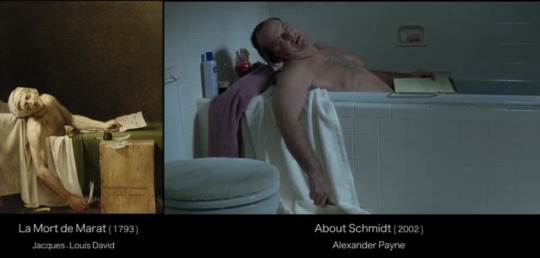
(from Vugar Efendi on youtube)
Artists can use films as references. The actions and emotions of actors could be used as anatomy and expression studies. The set designs and locations, whether real or not, could be references when drawing backgrounds and environments. Like in all fields of art, colors are used to convey and elicit emotions as well as to set the mood of a certain scene or entire film. They are also used to give emphasis on a subject or message, like the little girl’s red dress in the otherwise black and white film “Schindler’s List” (1993). Being the only subject with color in the film, the audience’s attention is purposely drawn towards her and so we see the full impact of the happenings in the story.

Visual symbolism is also prominent in films, and upon understanding how filmmakers do this, artists can do the same with their art pieces. The aforementioned girl in a red coat is an example of this. In Bong Joon-Ho’s “Parasite” (2019), lines are subtly used to divide the characters of differing social classes, which is the main theme of the film.

In Denis Villeneuve’s “Prisoners” (2013) and Stanley Kubrick’s “The Shining” (1980), mazes are used to symbolize the character’s psychological struggle and growing insanity (Storytellers, 2017) .


Symbolism through color and cinematography are often subtle and could not be noticed right away, but it adds layers to the work. Most of the time, symbolism in films are not explicitly explained and would require further reading to fully grasp the intention of the filmmaker. However, it is this added depth that makes some films masterpieces, and adds to the film’s rewatch value. Researching about the symbolisms used in films can spark interest about certain topics such as the history of objects or the meaning of symbols, thus giving an artist inspiration. Watching how filmmakers incorporate symbolism through objects, framing, positioning of subjects, or the environment in which the subjects are in can teach artists how to add symbolism in their work as well.
Watching films of different genres from different countries and time periods can allow artists to explore various visual styles and help them to train their eyes and develop a more creative perspective.
With all that being said, here are a few movie recommendations that could, in one way or another, give artists some inspiration because of their artistry and visual brilliance:

The Mirror (1974) directed by Andrei Tarkovsky

Spirited Away (2001) directed by Hayao Miyazaki

Amelie (2001) directed by Jean-Pierre Jeunet

The Grand Budapest Hotel (2014) directed by Wes Anderson

In The Mood For Love (2000) directed by Wong Kar-wai

Blade Runner 2049 (2017) directed by Denis Villeneuve
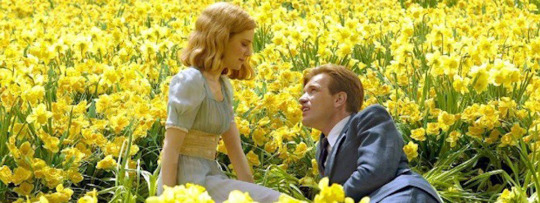
Big Fish (2003) directed by Tim Burton

Parasite (2019) directed by Bong Joon-ho
If you are interested in knowing more about films and watching well made film analyses, some excellent Youtube channels are: CineFix, Indy Mogul, Now You See It, Every Frame A Painting, Lessons From The Screenplay
References
Lee, N. (2020). How golden globes winner quentin tarantino steals from other movies. Retrieved from https://www.businessinsider.com/quentin-tarantino-movies-steals-cinema-homage-reference-2019-7
Tihai. (2011, January 24). Robert altman on rashomon by kurosawa [Video file]. Retrieved from https://www.youtube.com/watch?v=oYWQa0GExt8
Vugar Efendi. (2016, September 20). Film meets art II [Video file]. Retrieved from https://www.youtube.com/watch?v=pfR8bH_Fe8Q
Storytellers. (2017, September 10). Prisners: symbolism done right [Video file]. Retrieved from https://www.youtube.com/watch?v=fekd6LcnSyw
0 notes
Text
Split (2017) SPOILERS and the future for Shyamalan
So, Total spoilers for Split, so if you haven’t seen the film, please don’t read this if you’re looking to see it.
As many of us know by now, the “after credit” scene basically puts this entire movie in a different perspective. Kevin is does not have a real life multiple-personality disorder, it is very much supernatural.
FROM THIS POINT ON, THERE WILL ALSO BE SPOILERS FOR UNBREAKABLE (2000)
In the after credit diner scene, a group of patrons are discussing someone similar to Kevin, and how he was sent to a mental institution for his crimes against humanity. A man in the diner, played by Bruce Willis, confirms that the man’s name was in fact “Mr. Glass.” The very same Mr. Glass, played by Samuel L. Jackson, that was in Unbreakable. Meaning that man in the diner was in fact David Dunn, the main protagonist of Unbreakable. Split and Unbreakable take place in the same universe.
For years people have been talking about an Unbreakable sequel, and I’ve always said I thought it was a bad idea. Unbreakable is such a perfect film with such an amazingly underrated ending that a sequel was just blasphemous to me. Well, sitting in the theater a few days ago and watching that scene, I had a completely different outlook on it. Not only do I want an Unbreakable sequel, I think Hollywood NEEDS one.
With the major influx of repetitive and formulaic comic book films, a follow up to one of the most ahead of its time films in the genre is exactly what we need. Unbreakable took the comic book genre in a fresh new genre before they were even popular. I firmly believe that a new and exciting story with a lot of depth and drama can come from an Unbreakable/Split crossover film.
If done right, this is exactly what can get M. Night Shyamalan back on track in gaining a reputation as one of the most respected directors of this generation. Unbreakable proved that he has an ambitious and revolutionary mind, and knows what to do with it. Split proves he knows how to masterfully and respectfully handle that same universe. By this point, a sequel wouldn’t just be interesting, it would pretty much be necessary.
17 notes
·
View notes
Text
New from Kevin Wozniak on Kevflix: Review – The Irishman
In arguably the most iconic shot of Martin Scorsese’s 1990 gangster masterpiece Goodfellas, Scorsese uses a tracking shot to follow Henry Hill (Ray Liotta) and Karen (Lorraine Bracco) as they go from the front of the Copacabana to the inside using a side door and cutting through back hallways, staircases, and even through the kitchen to then pop up at the front of the club, where a busboy brings out a table for them right in front of the stage with a fresh bottle of champagne. All of this set to The Crystals “Then He Kissed Me”.
The opening of Scorsese’s latest film, The Irishman, is similar to that shot from Goodfellas. We get a slow moving tracking shot set to the doo-wop jam “In the Still of the Night” by The Five Satins. Only this time, the tracking shot isn’t through a club and it isn’t with a young, attractive couple who’s relationship is blossoming. This time, Scorsese tracks through a nursing home. A brightly lit, white-walled nursing with old people and nurses slowing moving around the home. The tracking shot ends on Frank Sheeran (Robert De Niro), an elderly man who looked like a skeleton with white hair sitting in a wheel chair. This immediately sets the stage for The Irishman. This is a movie that may have been made by Scorsese, but he’s a far different filmmaker than he was twenty-nine years ago. This is a film made by an older, wiser director who made a movie not so much about crime and gangsters, but about time, regret, and loyalty. The Irishman isn’t Goodfellas or Casino, but a new gangster classic from Scorsese and one of the best movies of 2019.
The Irishman, based on the novel I Heard You Paint Houses by Charles Brandt, takes a look at the life of Sheeran and his life working for the mafia, from starting out working for the Russell Bufalino (Joe Pesci) to his relationship with Jimmy Hoffa (Al Pacino) and his involvement in Hoffa’s slaying.
Netflix financed and is distributing The Irishman and I honestly couldn’t be happier with this decision because there is no way any studio would green light everything Scorsese did here. This is a three-and-a-half-hour long crime epic that spans over decades. We watch Sheeran, Bufalino, Hoffa, and a number of other characters age throughout time and rather than hire different actors to play each character in each part of their character’s lives, Scorsese decided to push the new and popular de-aging technology to the max by using it on De Niro, Pesci, and Pacino. It’s kind of startling at first when you first see it, but you can’t help but be in awe at how far this technology has come. Turning 70-plus-year-old actors back into their fifties is an incredible feat and shows how far this technology has come along.
What’s best about the de-aging technology is that it doesn’t take away from the performances in the film. De Niro gives his best performance in years as Sheeran. Sheeran is a man who is good at what he does. He knows he’s good at his job and he takes pride in it, always coming through when he’s needed even if it takes him away from his family. Sheeran wasn’t a loud guy, but De Niro makes sure we know how he’s feeling through his eyes and how he delivers his lines. It’s a sad, moving performance that looks at a man who has been living with the guilt of the relationships he’s squandered and regret for how things turned out in his life.
Joe Pesci came out of retirement for his performance as Russell Bufalino and what a decision it was. Pesci gives the best performance of 2019 and I will be amazed if I see a better one. Much like Pesci’s character in Goodfellas, Tommy DeVito, Bufalino is a man you don’t mess with. But unlike DeVito, who was a raging psychopath with his finger always on the trigger, Bufalino never raises his voice. He’s a man who moves in silence and one who will never get his hands dirty, but knows how to solve any issues he has. But even with his calm, quiet demeanor, Bufalino is a terrifying man and someone you don’t want to double cross. Pesci conveys this masterfully and gives a performance that reminds us just how great of an actor Pesci was.
Pacino has the loudest performance in the film, but he never goes overboard. Jimmy Hoffa is a legendary person in history. He was a man who changed how people viewed unions and who’s death and disappearance was one of the great mysteries of the twentieth century. Working with Scorsese for the first time, Pacino brings Hoffa back to life. Pacino shows us how Hoffa was a big name in the union game, but when it came to dealing with the mafia, he was a small man who’s honor and name meant more than making a deal with criminals. Pacino hasn’t been this good since 2002’s Insomnia and I hope he continues to take great roles like this and give excellent performances like this.
Sheeran’s relationship with Hoffa and his loyalty to Bufalino is the driving force of The Irishman. Bufalino got Sheeran into this world. He saw a man who he knew he could count on and Sheeran came through, allowing himself to get to the ranks of watching over Hoffa. But as Sheeran becomes closer to Hoffa and actually becomes his friend, the mob begins to have different ideas about how they feel about Hoffa and what to do with him. Sheeran had never been pulled like this before and he must struggle with his loyalty and his friendship. Having Sheeran tell us this story as an old man gives us his first hand perspective but also shows us how he feels about the decisions he made and about the people he lost along the way. He may have done the things he did at the time, but looking back on it, maybe they weren’t the best decisions. The Irishman is a movie that looks at loyalty and friendship while also looking at how time affects our perspective and how we must live with the decisions we’ve made. This is a movie made by a wise director who is continuing to get older and is constantly looking back at his life.
Like all Scorsese films, The Irishman is a technical wonder. The three-and-a-half-hours fly by so fast, I honestly could have sat through another hour or two. The editing my Scorsese regular Thelma Schoonmaker is top-notch, the cinematography and set designs look great, and the rest of the ensemble, featuring the likes of Harvey Keitel, Ray Romano, Jesse Plemmons, Bobby Canavalle, and Anna Paquin, who is quietly amazing, all hold their own with the three legends. The Irishman is a different kind of Scorsese film, but it is still a masterful piece of filmmaking that will go down as one of the great movies of 2019.
Follow Kevflix on Twitter and Instagram, @kevflix, and on Facebook by searching Kevflix.
The post Review – The Irishman appeared first on Kevflix.
from Kevflix https://ift.tt/2pQuNX7 via IFTTT
from WordPress https://ift.tt/2robHba via IFTTT
0 notes
Text
A Hollywood Fairy Tale
When Quentin Tarantino’s debut feature Reservoir Dogs was released in 1992, the American film industry was in crisis. Cracks were appearing in the star system. Mainstream films were flopping at the box office. Audiences wanted something, anything new, and Hollywood didn’t know what to give them. For a moment, there was a window for Tarantino to pass through. Along with independent filmmakers like Steven Soderbergh, Paul Thomas Anderson and others, he irrevocably changed movies and culture.
But 1992 was a long time ago. Sure, Tarantino was a big swinging dick—still is to a degree. He’s one of the vanishingly few filmmakers who can basically do whatever he wants, one of the few that actors will crawl through broken glass to work with. When he writes a screenplay, directs a scene, and his name appears in the credits, people pay attention. Only not in the way they used to.
That’s the way of things, isn’t it? We do what we do. With a little luck, we’re good at it, or at least we’re in a profession we don’t despise. As time passes, it can seem that the world passes us by. To deal with it, we look back on better years and better times and immerse ourselves in nostalgia. Nobody ever said any of that would be easy.
As of this writing, Quentin Tarantino is 56 years old. He’s survived in a film industry that’s changing again. How does he feel looking at the landscape? Seeing media juggernauts like Disney dominate the box office, knowing that fewer people are willing to even go to movie theaters, understanding that the specific passions he has are slowly becoming irrelevant. He does what nearly all of us do. He casts his eyes to the past, and his ninth film* Once Upon a Time…in Hollywood bears that out.
As in every year, things change. Rick Dalton (Leonardo DiCaprio) is very aware of that change. He’s a television star on the popular Western Bounty Law—or, at least he used to be. Rick is getting older. The parts he used to be offered, the heroic lead, are drying up. Now, he’s playing lots of villains. He’s well on his way to becoming an alcoholic. Big-shot agent Marvin Schwarzs (Al Pacino) thinks Rick needs to head for Italy and a new career as a spaghetti Western star.
Cliff Booth (Brad Pitt) is aware of the change. For years, he’s worked as Rick’s stunt double. Need a guy to fall off a horse, get punched, or fly through a window? Cliff can do it. He’s also Rick’s best friend and gofer. Need a guy to fix the rooftop TV antenna or perform taxi service? Cliff can do it. There’s a darkness in Cliff’s eyes, something that gets him on the wrong side of people, and a nagging rumor about his past that won’t go away. That all makes him a little reckless, so much so that he might even take a poke at the legendary Bruce Lee (Mike Moh).
Sharon Tate (Margot Robbie) is thrilled by the change. She’s Rick’s next-door neighbor, and she’s spent years climbing the Hollywood mountain, performing in some less than memorable projects. But she’s in The Wrecking Crew, co-starring with Dean Martin, of all people! As a klutzy spy, audiences love her, and this could be the moment that she becomes a major star. As far as she can tell, she’s on her way to a memorable career.
While some ride the waves of change, others wait for their moment to blow it all apart. At the isolated Spahn Movie Ranch, plans are being made to do just that. A group of hippies has exploited the kindness and senility of George Spahn (Bruce Dern). Their energy is all over the map, and we can feel the seething anger of Squeaky (Dakota Fanning), the paranoia of Gypsy (Lena Dunham) and the resentment of Tex (Austin Butler). On their own, they’re harmless. Their leader Charlie (Damon Herriman) knows that if their energies can be properly channeled, they can change the world.
Based on what I’ve told you, you might think that Once Upon a Time…in Hollywood is either an elegiac meditation on the Good Old Days of Hollywood or tragedy porn about the Manson Family murders.** It’s neither of those things. Tarantino has directed a fairy tale exploding with life and energy. It doesn’t have a plot as such. Instead, it’s a hangout movie about a time, a place, and the specific people trying to navigate it. While the film is long as hell and meanders, Tarantino still has it when it counts. Just when you feel like the pacing has slowed to a glacial crawl, he’ll throw in a line, a moment, or a sequence that immediately engages. A scene with Brad Pitt at the Spahn Movie Ranch has a quiet unease that is masterfully stretched to nearly the breaking point. OUATIH doesn’t have the diamond-hard edges of Pulp Fiction or the rampaging energy of Inglourious Basterds, but a director of Tarantino’s caliber simply doesn’t make bad films.
The same goes for his script, though there’s a controversy attached that we’ll discuss momentarily. This is the first film Tarantino has made that has the perspective of an older man. It’s marinating in nostalgia, despite the fact that Tarantino would have been around six years old at the time the film takes place. It doesn’t matter, because this era of film and cultural history has always been the closest to Tarantino’s heart. He’s always loved high art and trash cinema smashed together, and that love is why we have long, long scenes of characters watching/commenting on period-appropriate TV, movies, commercials, and other pop culture ephemera. In this case, Tarantino simply couldn’t kill his babies.
Remember the controversy I mentioned? There’s been a great deal of agita lately about the number of lines Margot Robbie was given and about what it means in the larger cultural conversation.*** The case has been made that the film is sexist since male characters are constantly explaining Sharon Tate’s life and what she means, whereas she rarely has a moment to advocate for herself. While I take their point, I think it runs into a noticeable trend these days. Too often, instead of engaging honestly with art, folks will come to it with their own preconceived notions and expectations. If the artwork doesn’t fit into a certain framework, it becomes problematic. The way I read it, the film is Rick and Cliff’s story. Robbie’s Tate is meant to be a juxtaposition of DiCaprio’s Rick Dalton. As her star rises, his falls.
Tarantino also excels at coaxing outstanding performances out of his cast. As the needy and pathetic Rick, DiCaprio does career-best work. He’s completely free of vanity, and he owns the wistfulness that we often get when we’ve gotten older and worry that this is as good as it will ever get. His chemistry is excellent with the laconic Brad Pitt. Pitt has never gotten the credit he deserves for being an outstanding actor. He makes it look so easy, and he plays Cliff as a guy who’s not a psychopath, but certainly seems psychopath-adjacent. Margot Robbie is one of the best in the business, and her performance as Sharon Tate is luminous. Watch the scene where she watches herself in the movie theater and the delight that washes over her face. She’s immensely likable and seeing her pregnant in August of 1969 created some serious anxiety.
Not everyone will enjoy Once Upon a Time…in Hollywood, particularly the ending. I understand the perspective of those who are done with Quentin Tarantino and his schtick. His time may very well have passed. The fact remains that, while it’s not his best film, it’s a work of art. For at least a little while longer, he’s a vibrant and dynamic filmmaker who’s made a film that’s complex, self-indulgent, and powerful.
*I know, if you look at his filmography, there are clearly 10 films just sitting there. To explain, Tarantino shot Kill Bill intending it to be a three-plus hour epic and was forced to cut it into two movies.
**Sharon Tate, Abigail Folger, Jay Sebring, Wojciech Frykowski, and Tate’s unborn child were murdered on August 9, 1969. OUATIH was originally scheduled to be released on August 9 of this year. Officially, the studio claims the release date was changed to give the film a chance to compete in a crowded marketplace. I like to think that someone at Sony said, “Um…guys? Is this a date we really want to commemorate?”
***You can read more about it in this exceptionally well-written article that I disagree pretty strongly with. Is there problematic art? Sure. Is Tarantino a racist or a misogynist? I don’t think so, because there’s a massive gulf between being provocative and being hateful. Let’s remember that we all read art differently, and it’s important to consider the artist’s intent.
from Blog https://ondenver.com/a-hollywood-fairy-tale/
0 notes
Text
This slideshow requires JavaScript.
Now we come to the Best Director category. Like quite a few categories that year, the Academy still seemed to be finding their feet. They divided up Best Director into two categories, one for Best Dramatic Picture and one for Best Comedy Picture, not unlike how the Golden Globes eventually ended up dividing some of their categories. I’m sure they soon realized that some years this wouldn’t have ended up feasible, for while there’s always a ton of great dramatic films each year, it’s much harder to find good comedies. It’s much harder to make someone laugh then make someone cry. I will stand by this no matter what anyone says.
The first picture nominated in the category was Sorrell and Son, directed by Herbert Brenon. Maddeningly, as much as I scoured the internet, I was unable to find a copy of it anywhere, though the Academy Film Archive is said to have a partially restored print. Someone tell them to get that out on a DVD and for download toot-sweet!
So that takes us to the other picture nominated that year: The Crowd. As finding a copy of this film on the net is an exercise in maddeningly ever getting closer to the edge of the abyss while you tear your hair out, I’ve included a link for it above. Now, I am all for paying money to watch films in a legal format and supporting good films that way, but that’s only if they’re actually available. But TCM, who runs this movie occasionally, has not done so, so I was forced to watch the pirated version. I feel no shame in telling you to do the same.
The Crowd is an All-American tale of a young man named John who moves to the big city with the intent of making it big. He wants to be a somebody that people will remember as his late father always wanted him to be. Rather hard in New York City, where there’s millions of people right along side you who want the same thing. Now, The Crowd managed to make this picture feel larger-then-life by filming right on the streets of NYC, sometimes covertly for crowd scenes. You get a sense of just how massive the place is as people stream about going from place to place. The camera has large, sweeping shots all over the place, as well as a lot of tracking shots, a style which would be lost for quite some time due to the limitations that sound pictures would soon present.
Now, just to get the elephant out of the room right away, there are a few moments in the picture where black actors are portrayed in the title cards to have the “black minstrel accent”, examples like ‘Did I hear you-all speakin’ ’bout havin’ yo’ bed made up?’ and ‘I detend to be a preacher man! Hallelujah!’ There’s also a moment you might cringe as the token black boy in John’s childhood town is nicknamed Whitey. So if you’re a bit sensitive to these things, which are somewhat common in this silent era, turn it off or fast-forward a bit. Remember, not everything in the past conforms to today’s standards. To be fair, in a nice bit of solidarity, Whitey is shown to be playing with the white children of the neighborhood without being ostracized or shown to be anymore comical then any of the other little boys, a scene that would begin to be lost as films progressed. Alright, with that out of the way, time to move onto the rest of the picture.
As usually happens in these kinds of pictures, he finds a nice girl named Mary, and they soon marry, with his best friend cynically saying it’ll last maybe a year. Despite her disapproving brothers and mother, and a few small squabbles, the two weather the storm together, and soon Mary is pregnant. They have a boy and then soon a little girl some time later. The picture skips ahead five years and everything is going along alright.
The family is at the beach on a picnic and their characters are laid out nicely for us: Mary is trying her best to make the picnic nice while John sits there lackadaisically playing a ukulele instead of contributing any help at all. When Mary asks him why he hasn’t gotten anywhere in his company, he protests it takes time. But based on what we’ve seen thus far between young John blowing off his studies to go on a date with Mary, then blowing off spending time with Mary’s family to get drunk with Bert, and this idea of letting his wife do all the work while he futzes around, it comes off more like he’s just lazy. She points out his best friend Bert has gotten somewhere and again he protests that rubbing elbows with the big bosses will get you anywhere. Well…yeah, and what’s wrong with that? A little hard work plus kissing up to the bosses never hurt anyone in my opinion.
But things seem to be turning around for the family as John, who keeps sending in slogan after slogan to contests that will select them as the new one for their brand finally wins a bit of money in the form of $500. ( That’s $7,345.99 in today’s money, people!) They happily pay off debts, buy a new dress for Mary, and buy new toys for their children. They excitedly tell them to come inside and that’s when tragedy strikes. In a masterful series of shots that hype up the tension by never showing us the actual moment of impact, their little girl is struck and badly injured by a truck.
The scene fades to a sad one as the little girl starts to slip away. Small wonder that John seems to lose it a little bit, hyperfixating on the idea that if it’s just quiet enough, she’ll get well. He goes all the way to running into the crowded streets of the city, battling against the crowd and futilely trying to get them and the fire trucks to be quiet. There’s a wonderful parallel here as the crowd which was once a source of inspiration and happiness has now turned cold and unfeeling, with a policeman flat-out telling him that the world isn’t going to stop just because his baby is sick.
The little girl dies, and in a scene full of pathos that never goes over the top, we see Mary and John in the throes of grief, both trying to be comforted by their family and failing. What happens next is best summed up by the title card: “The crowd laughs with you always… but it will cry with you for only a day.” John can’t focus on his work anymore and quits his job. This proves to be a dumb mistake as he then spends his time getting jobs and losing them just as quickly. This would be eerily prescient for the Americans watching this film, soon to be plunged into the Great Depression. By the time the story picks back up, they’ve moved to a small, dingy house, Mary is forced to take in sewing to make ends meet in addition to all her other work, and their poor firstborn son Junior is completely neglected.
Mary’s brothers sum it up nicely when they bitingly ask John if he plans to go on a vacation from life for the rest of his life. At this point, I started to lose my sympathies for John a bit. He just sits around in a daze, which is understandable, but in the meantime, his wife is holding the family together by taking on the lion’s share of the work. To contrast, while he’s throwing a fit and impulsively quitting his job, she’s busy making a feast for the company picnic while still in the throes of her own grief. As I’m sure all of you well know who have lost any beloved family member, life doesn’t stop just to let you spend your days grieving. Eventually, you have to get back out there and try.
Then comes the part in the picture where I wanted to smack him. Mary’s brothers say they’ll give him a job, but he refuses, saying it’s a “charity job.” This comes from a 2019 perspective, and I’m sure things were different ninety-one years ago, but this seems to me to stink with a bit of toxic masculinity. So it’s “charity” to take a job from relatives because of your stinking pride but sitting on your ass day after day moping is what…heroically supporting your family? Men have their pride, but they also have families that need to eat. Mary rightfully calls him out on this stupid line of thinking and slaps him, saying she almost wishes he were dead.
Junior follows his father as he walks around town depressed. He considers killing himself by jumping off a bridge but then reconsiders. After all, what’s the point? The shots here of the train and bridge are beautifully done. Junior, the poor little neglected son, finally breaks through to his father by telling him he believes in him. This finally snaps John back into action. He looks all over town for a job, eventually finding one as a clown wearing a sandwich board who juggles. It’s a contrast to the start of the picture when he made fun of just such a man with the same job when they were on a date.
But it appears to be too late, as when he returns, Mary seems set on departing with her brothers and taking Junior with her, even after he reveals he’s gotten a job. It’s a very tender scene, and at the end of it, Mary can’t do it. She stays with her husband and her brothers exasperatedly toss her luggage onto the porch when it becomes clear she’s not coming. The picture ends with the family attending a vaudeville show and seeing John’s winning slogan from earlier in the program. The shot fades out into a masterfully done tracking shot, pulling back from the little family we’ve followed until once again, they are lost in the crowd of people that make up the audience.
Now with such a good picture done about ordinary people, it is a bit of a headscratcher as to how it didn’t win a single award that year at the Oscars, though even I will admit the eventual winner was a smidge better. However, it makes a little more sense when you discover Louis B. Mayer, head of MGM, hated the picture and vocally urged his fellow members at the Academy not to vote for it, which honestly might have caused it to lose in both categories that it was nominated in. Small wonder, with the country going into the Depression five months after the awards ceremony, that people didn’t want to see movies with downer endings. Honestly, by today’s standards, it seems pretty optimistic, but back then, it was a bit of a bummer to see the family still struggling.
King Vidor was actually forced to shoot anywhere between reportedly seven to nine alternate different endings so that theaters could choose which one they wanted to show. To quote IMDB, one of the alternate endings was “set in a mansion showing John and Mary by a glittering Christmas tree. John has become a success at writing ad slogans. Mary’s new dialogue title was to read: ‘Honest, Johnny, way down deep in my heart, I never lost faith in you for a minute.'” Overwhelmingly, the theaters still showed the original ending, which says something about how people viewed it despite the negativity the ending might have stirred up.
Best Director, Dramatic Picture 1929: King Vidor for The Crowd and Herbert Brenon for Sorrell and Son Now we come to the Best Director category. Like quite a few categories that year, the Academy still seemed to be finding their feet.
0 notes
Photo

Excellent Read, Valuable to Anyone Marketing to Women Great book and very insightful for marketing to women. It's an easy read and you could easily get finish it in a day or two if you like to read. The book takes the position that women are not a segment of the market, they ARE the market. The examination of buying behaviors and social identity provides marketers real-life and effective techniques to reach the female buying market and markets influenced by women. ALL MARKETS! I've used the material in the is book and my business response has noticeably improved. Go to Amazon
Recommended to me by instructor at IUPUI I am enjoying reading this book that was recommended to me by instructor who taught "The Dynamics of Women's Giving" at Indiana University Perdue University, Indianapolis campus. So far, I am enjoying it! Go to Amazon
Invaluable Ideas, Information, Perspective There's so much valuable information in here. I wear several hats, as an activist, news and opinion site publisher and director of a non-profit and this book provided highly useful facts, perspective and advice for all three. Go to Amazon
If you are Married, or have been... SKIP THIS BOOK If you are a man, and have never been in a long term relationship, you'll probably need this book. Go to Amazon
Most useful, interesting book - get it before everyone else does! This book is fantastic! It provides research and case studies throughout, and key tips at the end of every chapter, making the ideas super usable and easy to implement. I found myself underlining things on every page and coming up with so many ideas about how to work this strategy into the marketing for my organization! Go to Amazon
much needed resource for activists and entrepreneurs What a great book! I recommend this to anyone interested in politics, government, communications, or social justice. I've ready numerous books on feminism, business, and communicating messages and this is up there with the best. Witter and Chen are great writers and brilliant thinkers, and they masterfully combine marketing analysis with the most current and innovative social data to explain not only why it is critical to market ideas and products to women, but also how to do so. If you are thinking of running for office, starting a new organization, selling an idea, or marketing a product, this is a must read and a must buy. Go to Amazon
Finally! As a woman in the communications profession with a husband in advertising, I am continually amazed how off the mark corporations and public interest organizations, not to mention politicians, are when it comes to knowing how to reach women. This book really gets it right, makes so much sense, and is a fun read as well. Easy take-aways, clear examples from real life. This is good stuff. Go to Amazon
Hit the nail on the She Spot! What a brilliant read and so long overdue. Having attended a women's college and taken my fair share of Feminism and Women in the Working World courses I can attest that this would have been my text book du choix. So insightful, helpful and easy to digest. Really well done - very thankful to have this one in my collection! Go to Amazon
A Must Read for Anyone Trying to Change the World SUPER SHE! Practical, sharp and insightful. Finally! Practical and insightful A must read
0 notes
Text
#1
Hip-Hop to me is a culture of creative rebels who use poetic rhythms and heavy beats to portray their lives. Hip-Hop is shocking and provocative while simultaneously being beautiful and humble. This culture has been the voice of the unheard, the anthem of the misrepresented. The reason it is so attractive to misunderstood youth is how it allows one to provoke outsiders and sooth insiders of the culture.
The convergence of Hip-Hop and design seems to be quite natural. Hip-Hop is art, everything that goes into it is intentional. Design and Hip-Hop are both highly expressive in different niches. Where Hip-Hop is expressive of youth and counterculture, Design is somewhat more objective being concerned with its user or a client.
#2
Commonly referred to as the spokesperson for African-American cinema, Spike Lee emerged in the 80’s as a radical cultural pioneer. Although his films empower the African-American communities, his aesthetic innovations are greatly underlooked. Having such a radical approach to visual style one would think Lee would be regarded along with other American directors such as Martin Scorsese and David Lynch but rather unfortunately his name is excluded. Considering the theme of Lee’s masterpiece “Do the Right Thing” is about racial tensions and features a script heavy with masculine men screaming racial slurs at each other, instead of allowing the drama to speak for itself Lee creates anxiety through the aesthetic of the film. A prime example of this is Radio Raheem, this character is larger than life in all aspects: his physical appearance, his huge boombox, and his blaring music. Whenever this character enters a scene he brings with him a blaring soundtrack that overpowers dialogue, something that if not done properly can be detrimental to the narrative. When shooting Raheem, Lee choses to use unconventionally low angles and tilts to subconsciously show the viewer that Raheem is a powerful force in the community. Directorial choices such as this are found throughout the film. One scene where Lee breaks away from his auteur style is the climax. Just before Radio Raheem and Buggin’ Out enter the pizzeria which in turn causes mayhem, Lee employs conventional coverage the actors already in the pizzeria in order to amplify the effect of his style when he returns to it.
#3
Examples of Hip-Hop used in film soundtracks
Public enemy in Spike Lee’s “Do the Right Thing”
https://www.youtube.com/watch?v=U35MvblI4og
In Lee’s film the use of Public Enemy’s hit song “Fight the Power” is meant to not only set the tone of the film but also to give the film a voice. Audio is an important aspect of this film and is commonly overlooked. Lee masterfully layers sounds in his films to create beautiful soundscapes that craft the world of which his narratives exist. In “Do the Right Thing” many times it’s as if the film is shouting directly at the audience, this can be attributed to his use of Public Enemy’s song. Whenever the song is played it is at the forefront of the soundscape, it is the loudest thing the audience can hear. This gives the film a rebellious tone and really pushes the audience to reflect on the song’s conceptual meaning within the narrative.
A Tribe Called Quest in Larry Clarke’s “KIDS”
https://www.youtube.com/watch?v=-DGyZD6cPdg
Much different than Lee’s approach to soundtrack, Clarke uses Tribe Called Quest’s “Oh My God” to elaborate on the setting of the film. Employed in such a way where the audience is unsure of the soundtrack is diegetic or non-diegetic until the end when the song fades almost to silence then back to being the forefront of the soundmix. This method hooks the audience into the scene by smoothly opening into the scene and just as the dialogue become prevalent the soundtrack fades away almost unnoticed until the scene finishes.
Coolio in John Smith’s “Dangerous Minds”
https://www.youtube.com/watch?v=VbNJLymneZ8
This use of hip hop in a film is strictly for marketing to the youth consumer. By employing a celebrity voice and popular song, the film gains motion within popular culture of the time. The use of the song has nothing to do narratively with the film nor does it set the mood, it works to bring in a broader audience base in order to drive sales.
#4
Black Ratchet Imagination lens is a perspective of persons that identify as black and/or queer within the community of Hip-Hop. Invented to create a definition for black and/or queer persons that advocates for their creativity. Through the use of this lens researchers can come closer to comprehending black queer youth cultural identities.
What I learned from this article is really what the term “Ratchet” really means within its introducing community. I grew up hearing that term thrown around with a very negative association and thus I have always thought of it negatively. I now understand its cultural relevance and the “messy fluidity” which is the definition of the term.
I believe that hop-hop can be extremely influential if employed in educational environments. In middle school, the administration would play classical music over the intercom system every morning and being 12 years old no students really listened. Playing music created by oppressive societies from history does little to nothing for young African American youth struggling with their identities. One day a local hip-hop artist came into the english classes, I can’t think of any one thing that got more students involved then that. It was the talk of the school for the months after. I believe that his involvement in hip-hop and willingness to talk in a school setting really opened young black youth’s eyes to a creative outlet that they needed to discover themselves.
#5
Big Shaq - London, UK
Michael Dappaah, otherwise known as his fictional rapper name “Big Shaq”, is a British comedian best known for his hit song as Big Shaq “Man’s Not Hot”. The song tells the story of the “famous” rappers obsession with keeping his jacket on even when people ask him to take it off replying with “Man’s not hot”. In an interview with NME Big Shaq was quoted saying “I could be in the Sahara Desert but im still going to wear the jacket”. What I feel is important about Big Shaq’s overnight success is that it shows that hip-hop can still be fun/humorous and still popular. In today’s culture It is my own opinion that rappers or music makers in general have become much too serious about everything. This is not to say that the issues they speak about are irrelevant but in such a saturated environment it’s easy to get lost in the sea of songs that either about how much money you have or political drama. “Mans Not Hot” gives one a humorous breath of fresh air that is well produced and creative.
0 notes